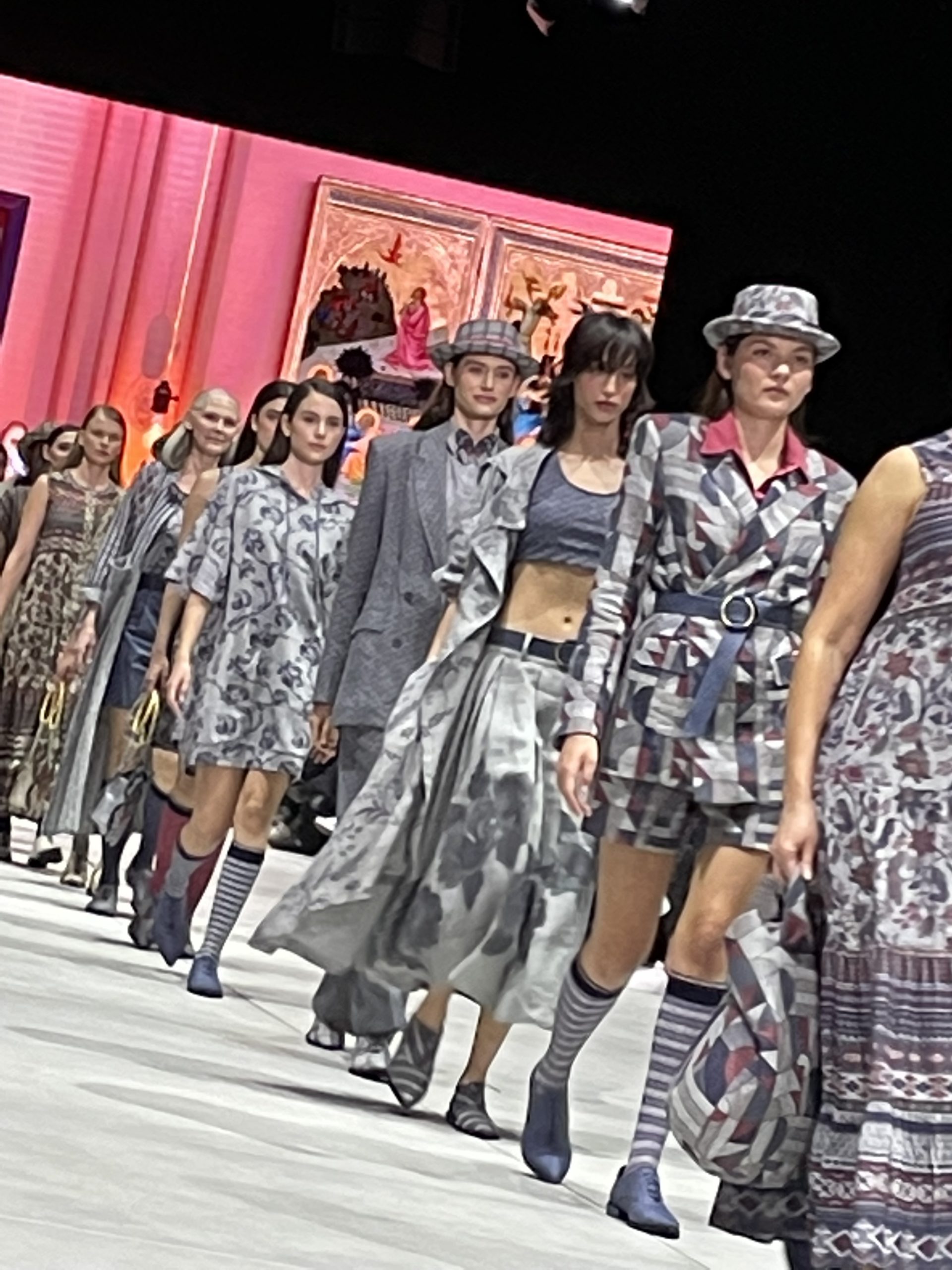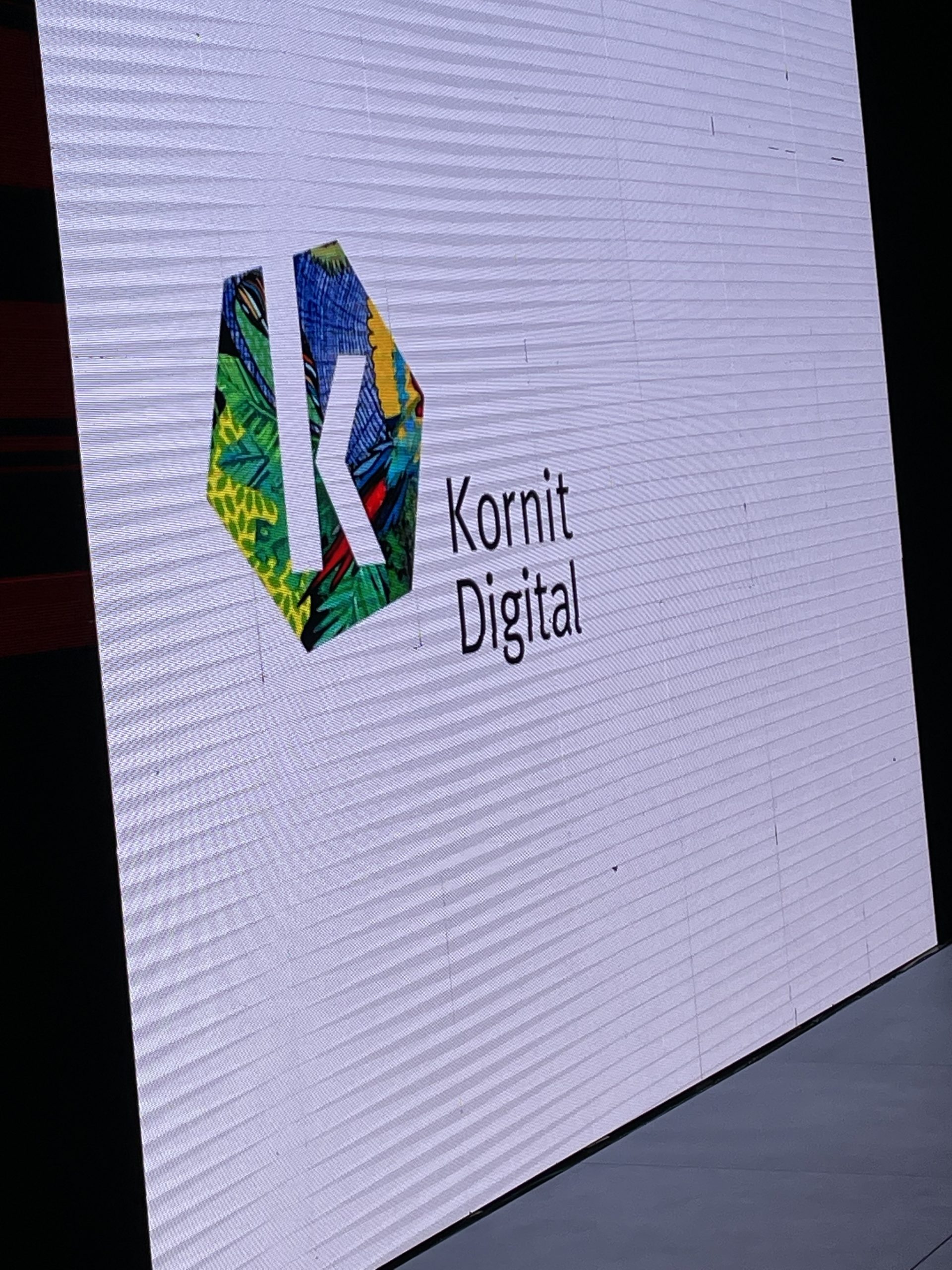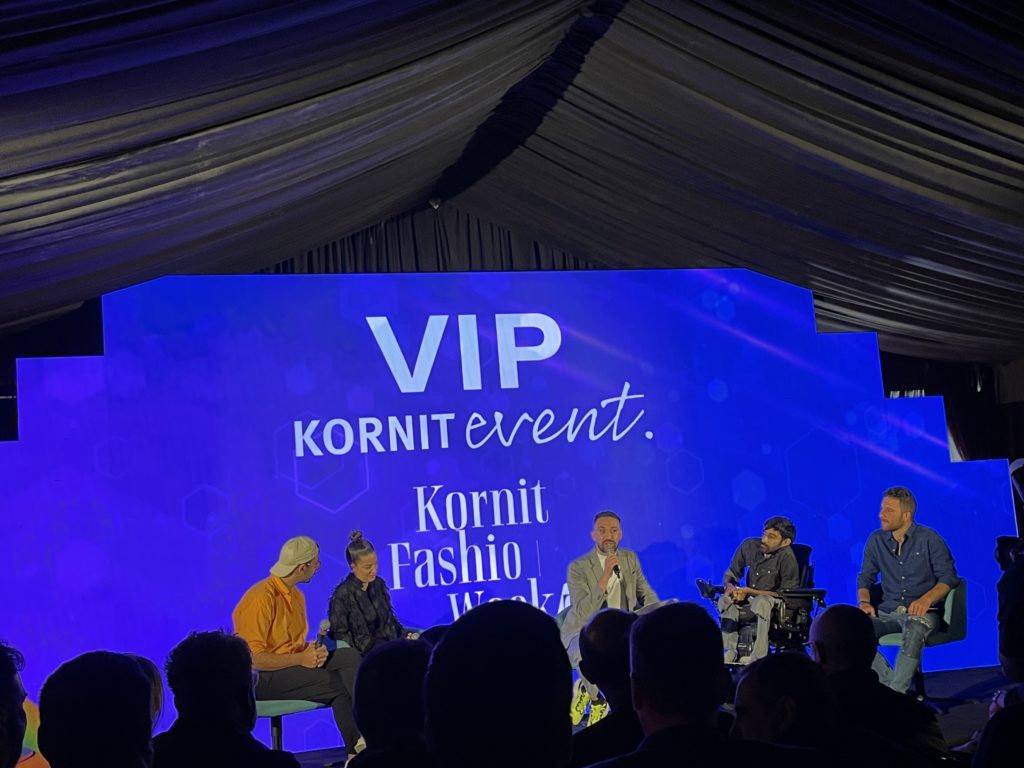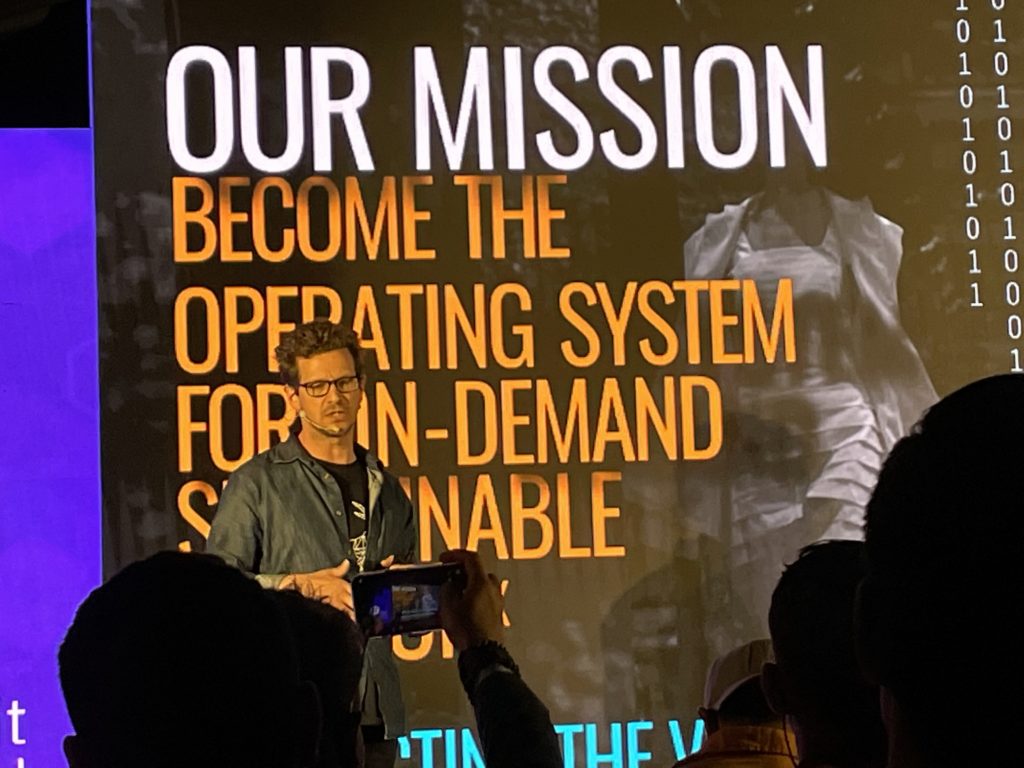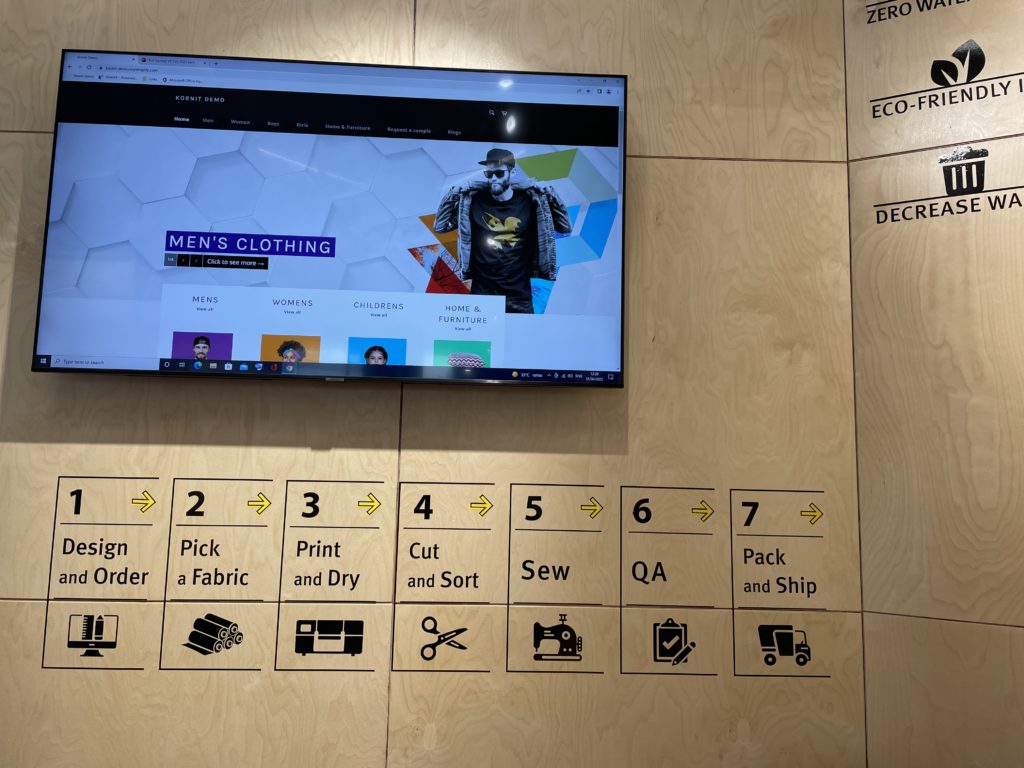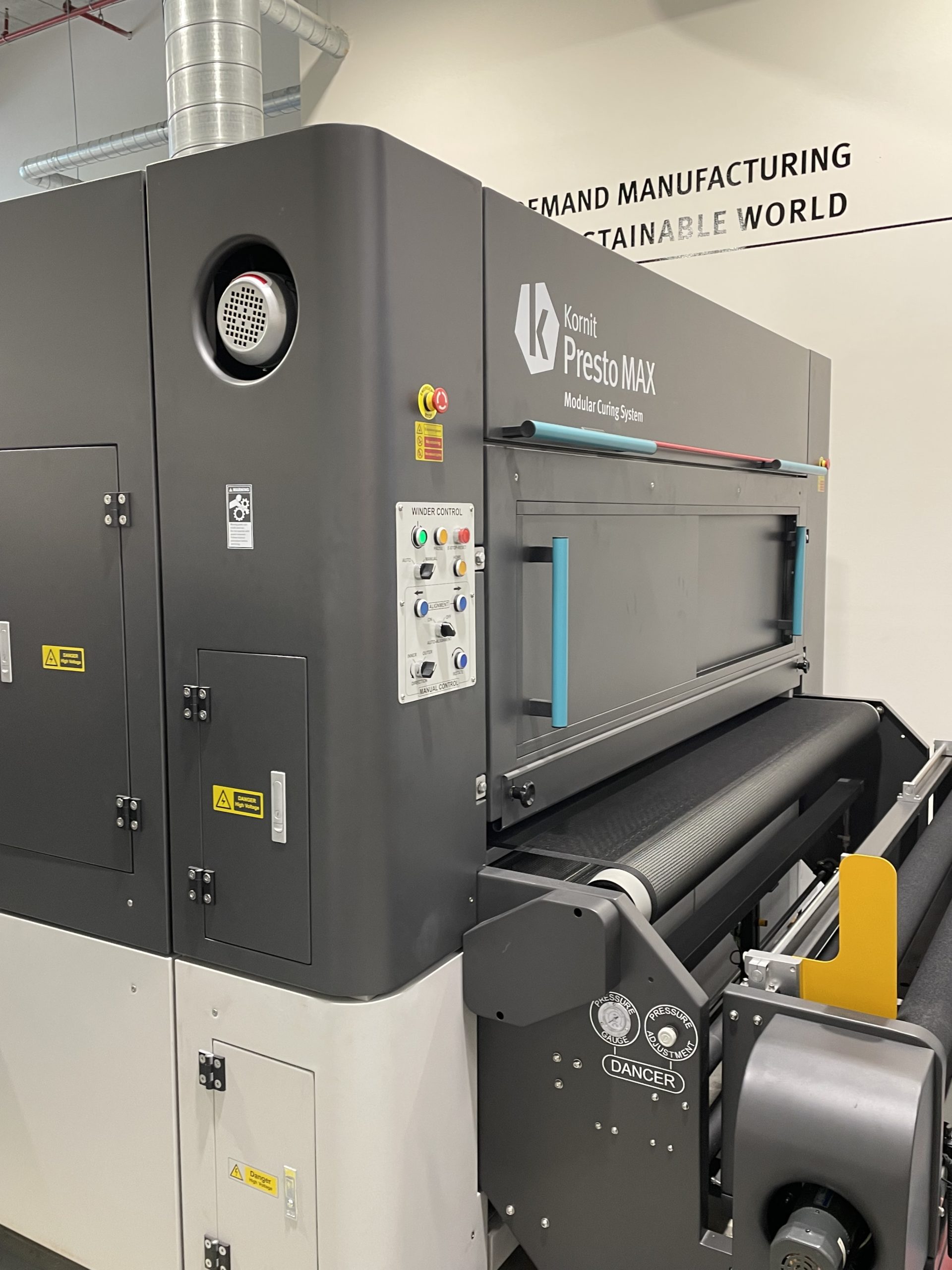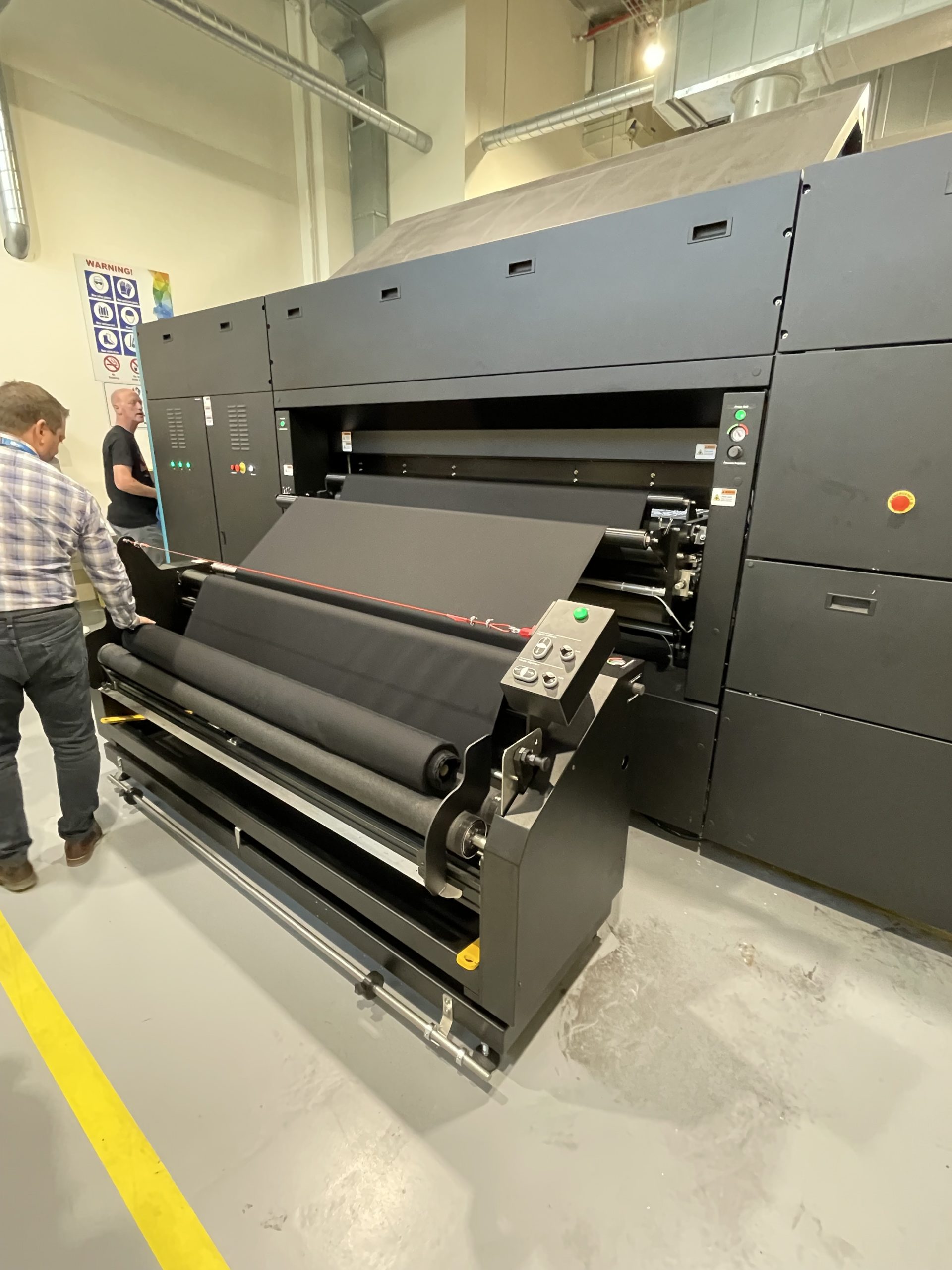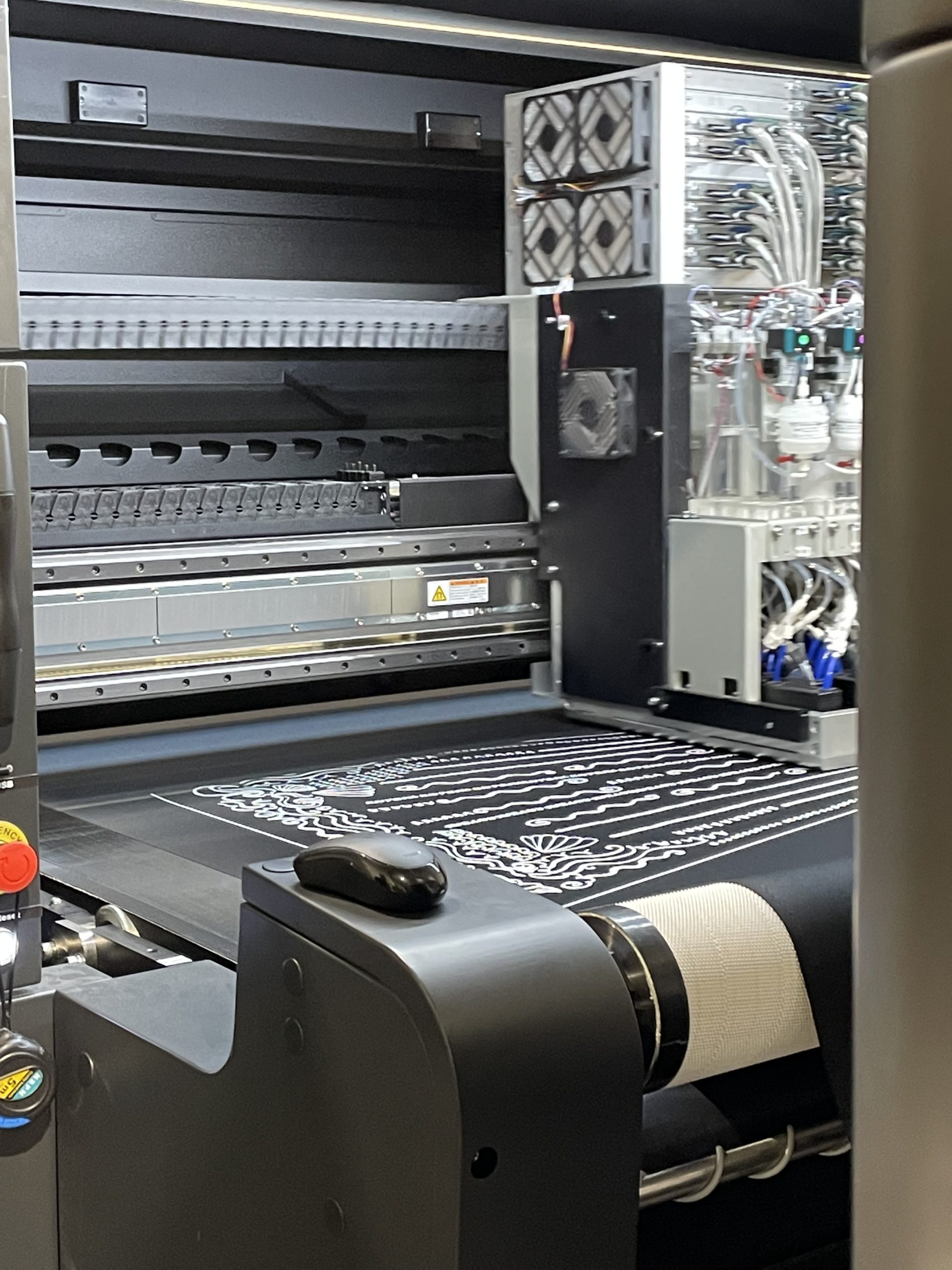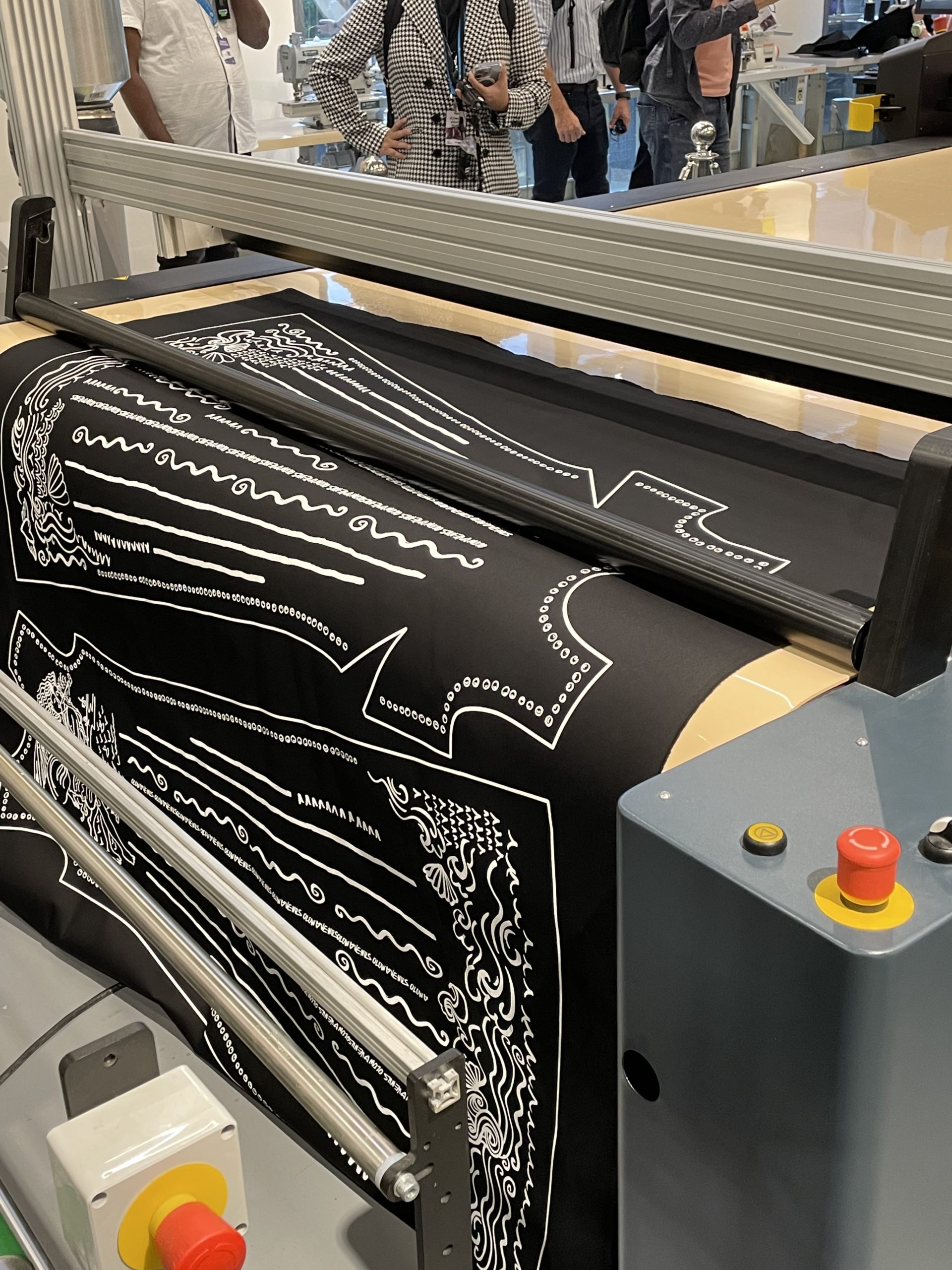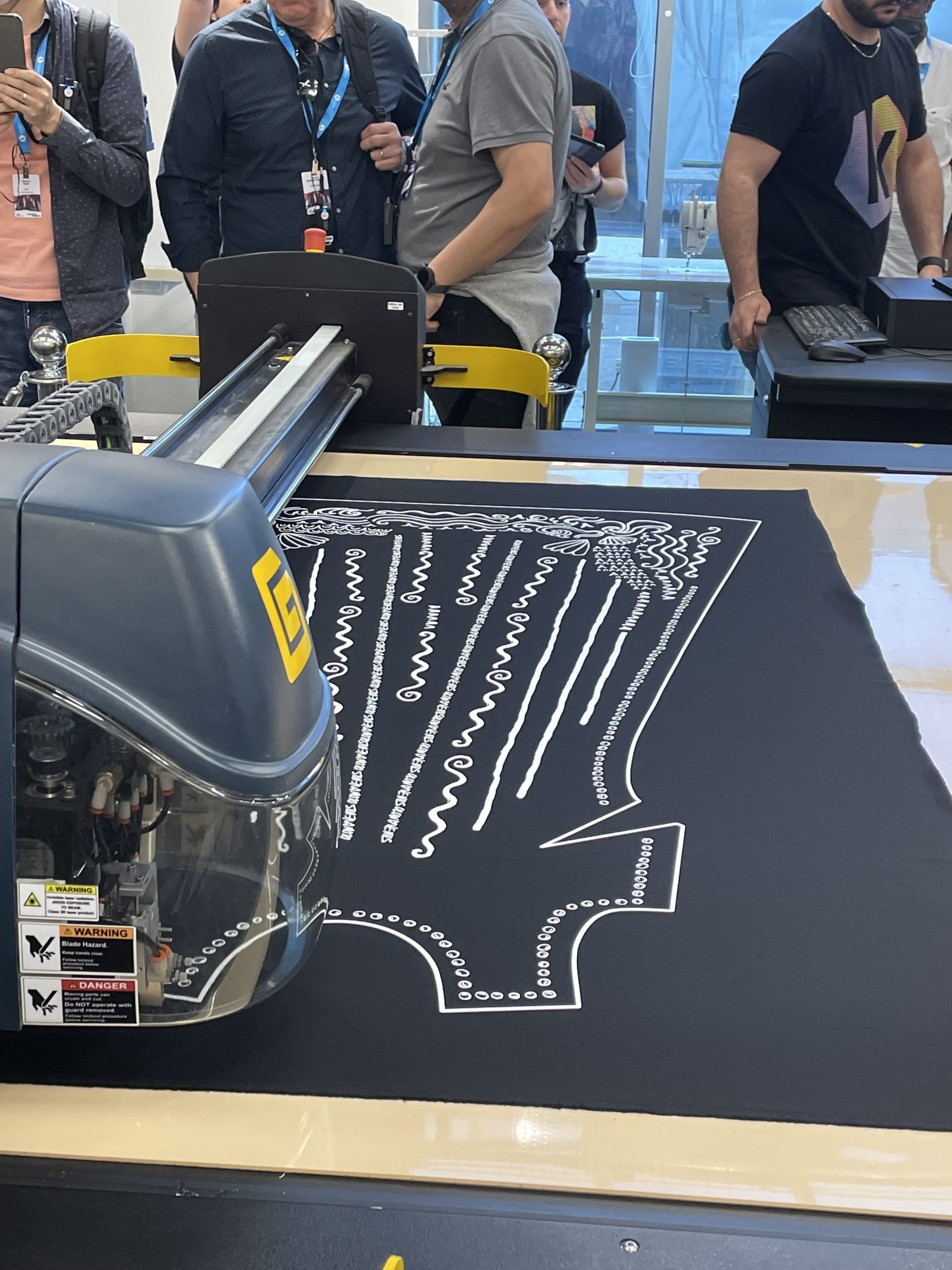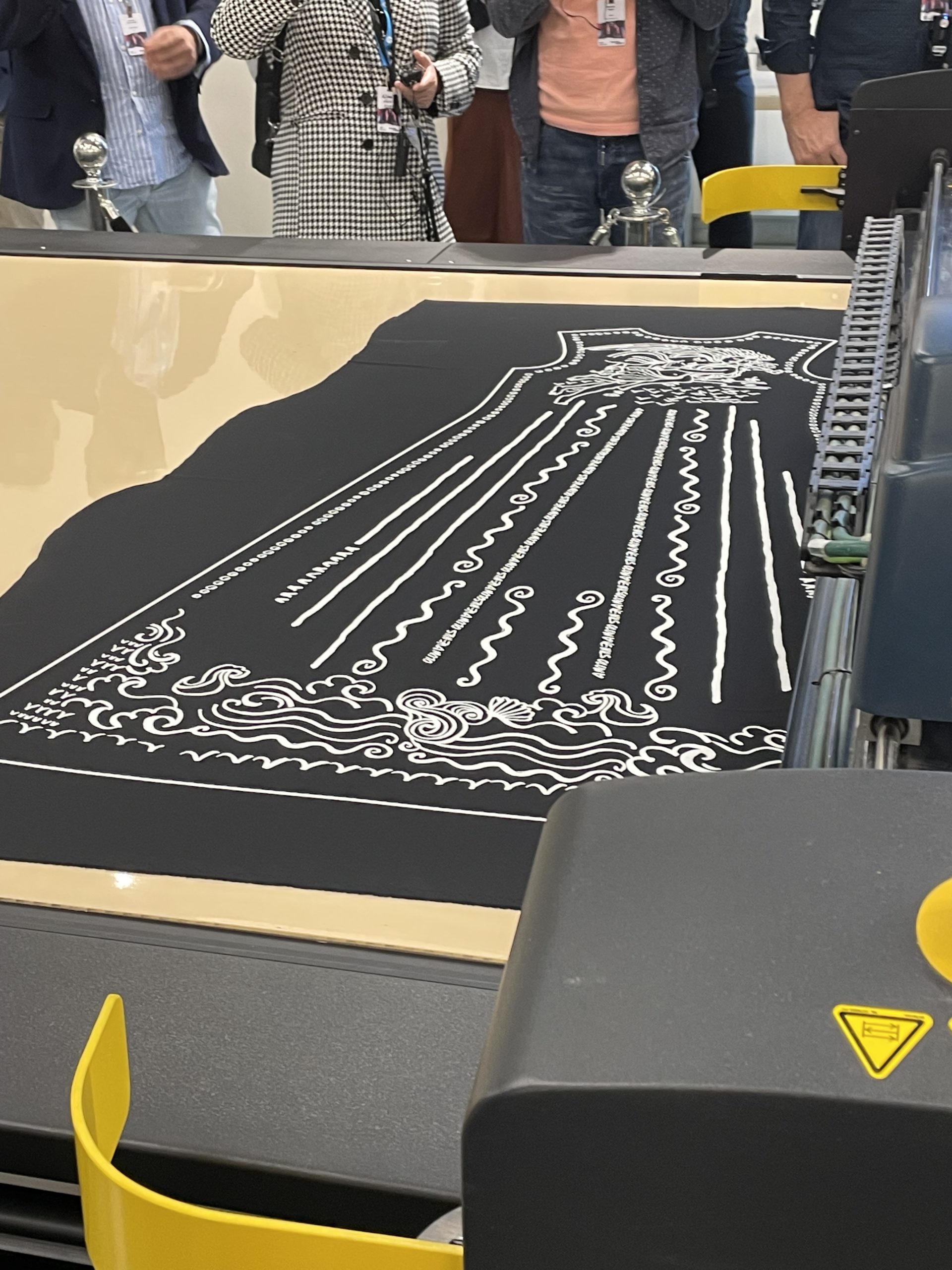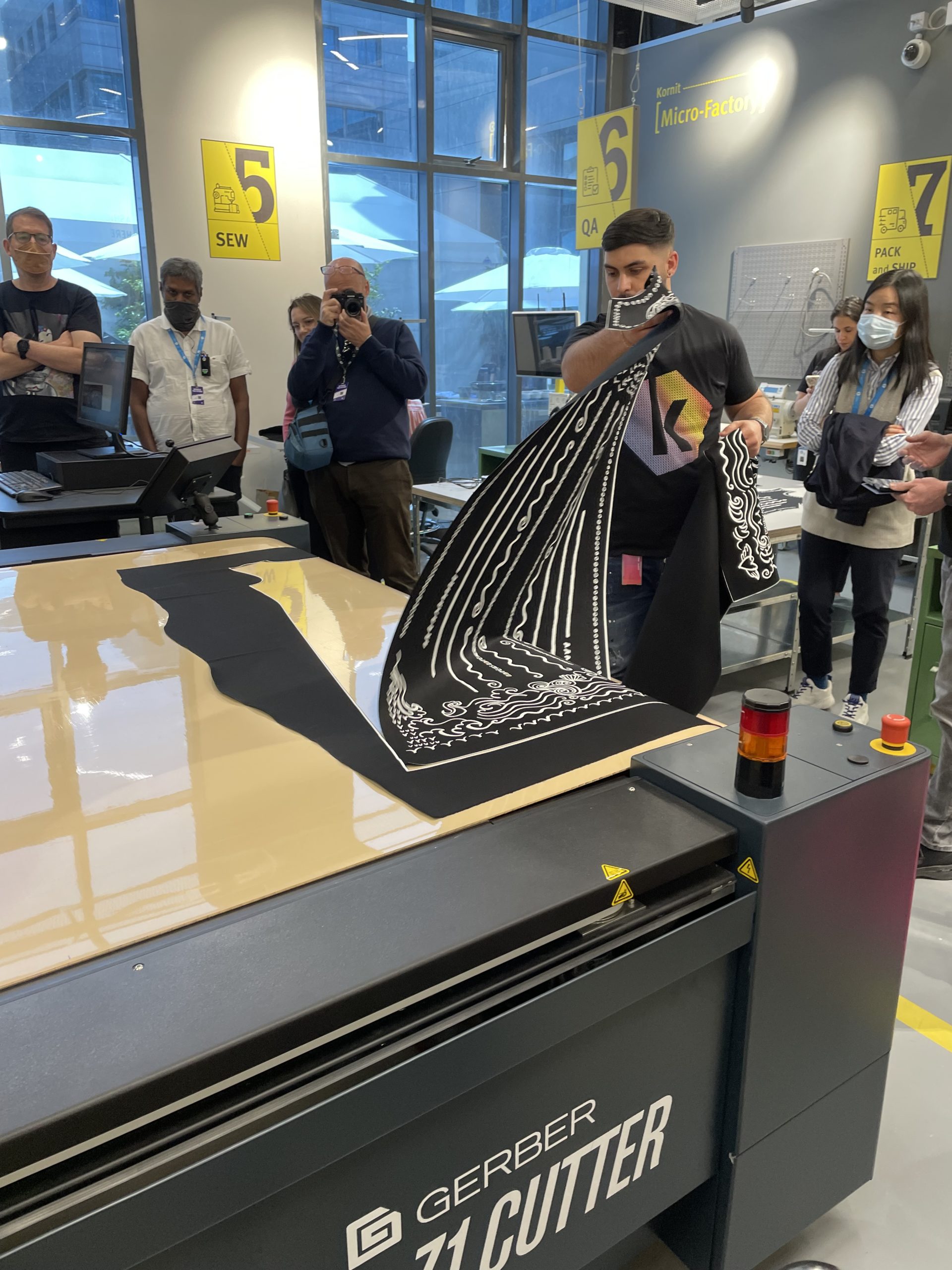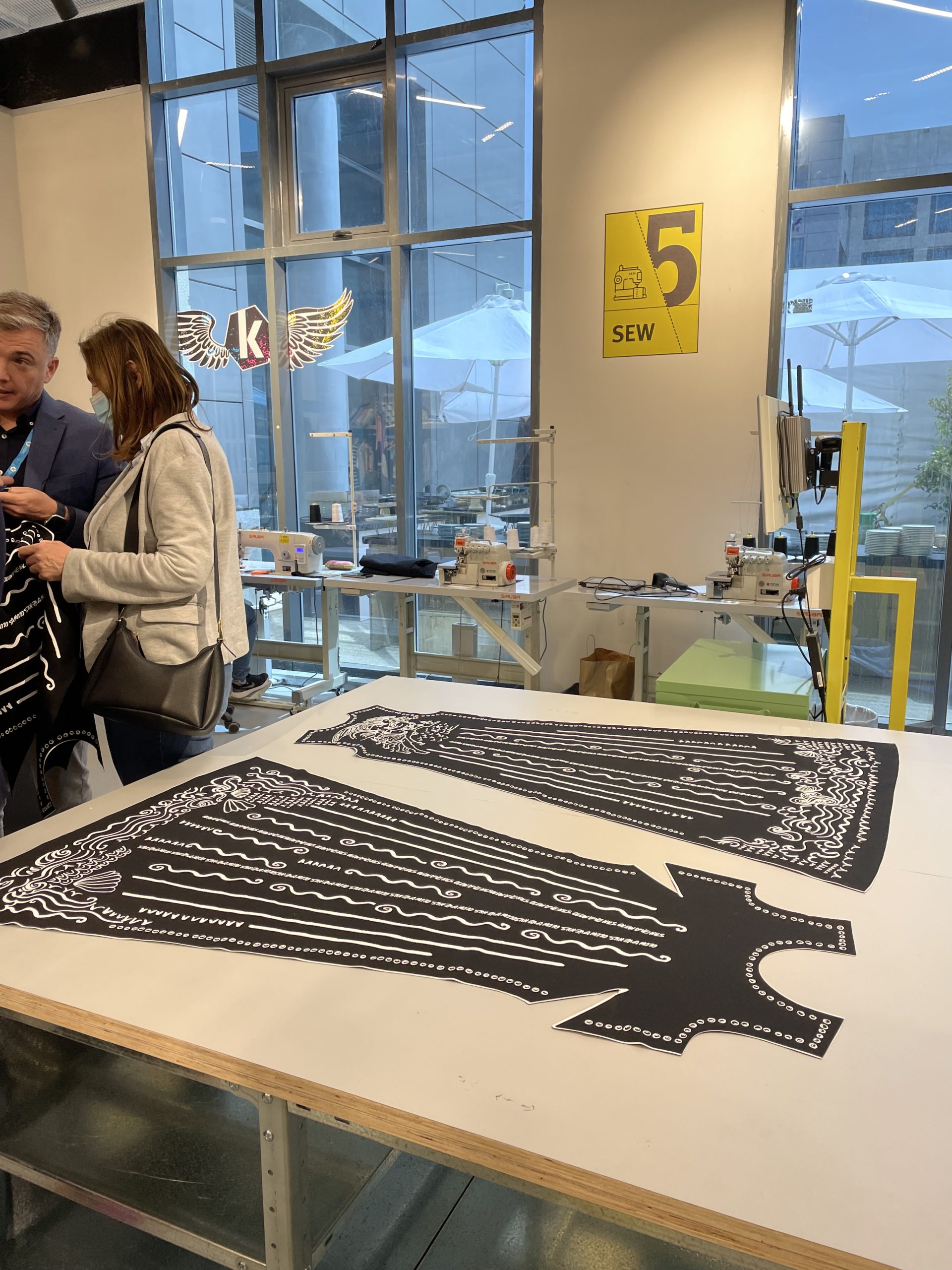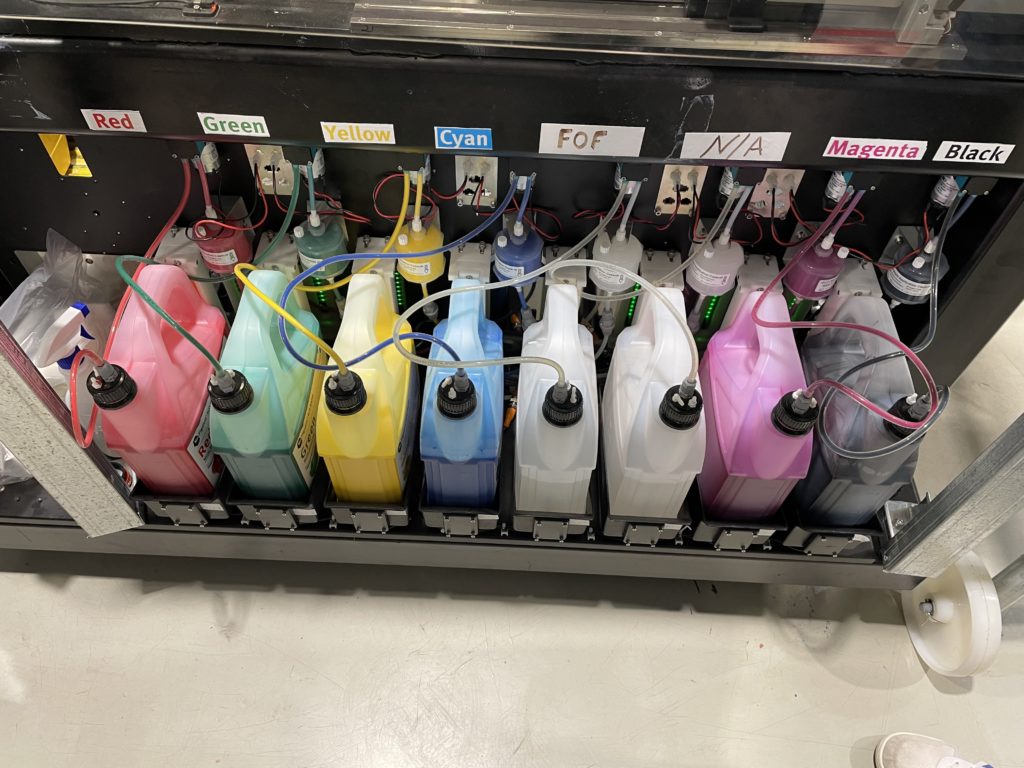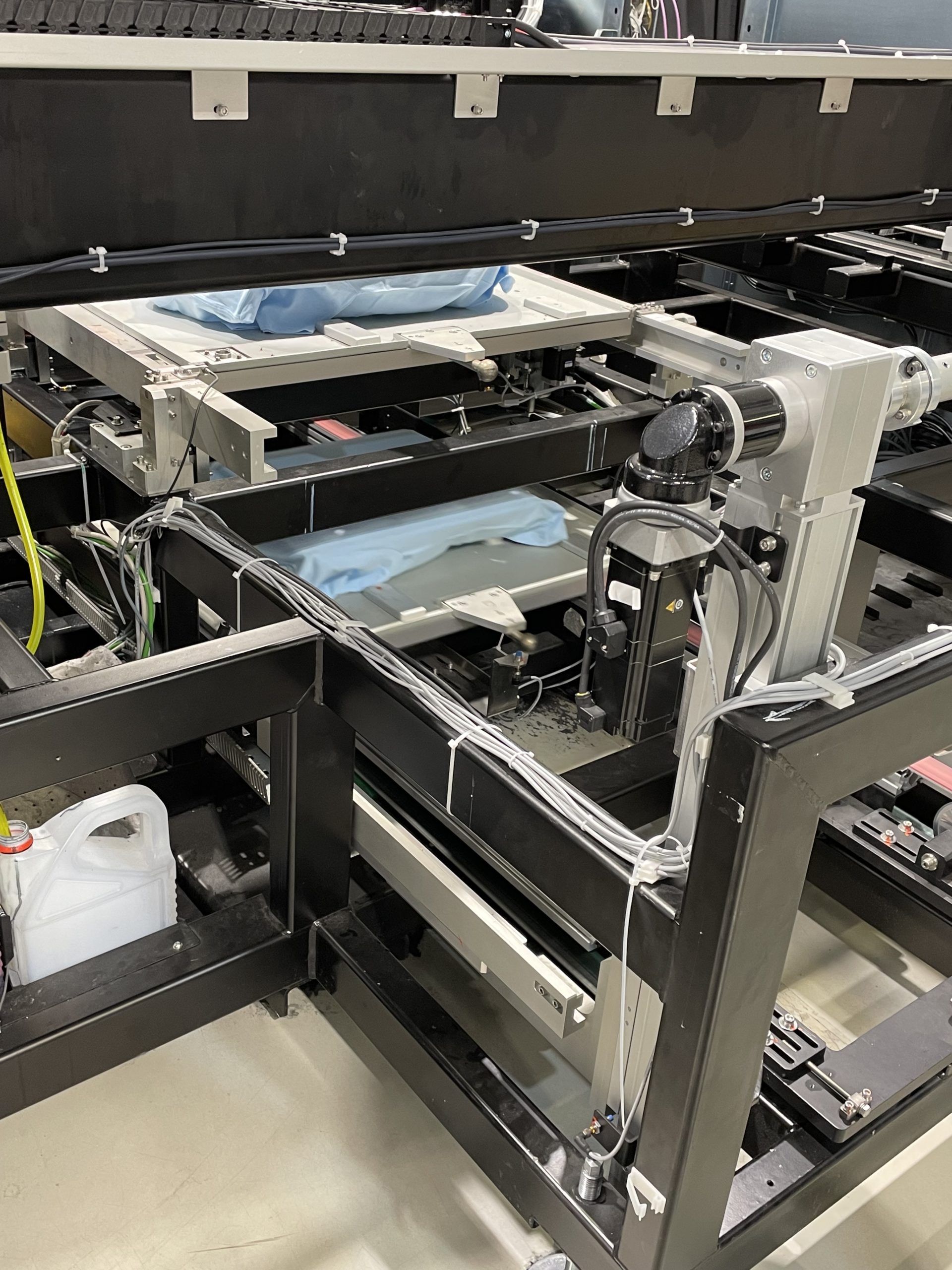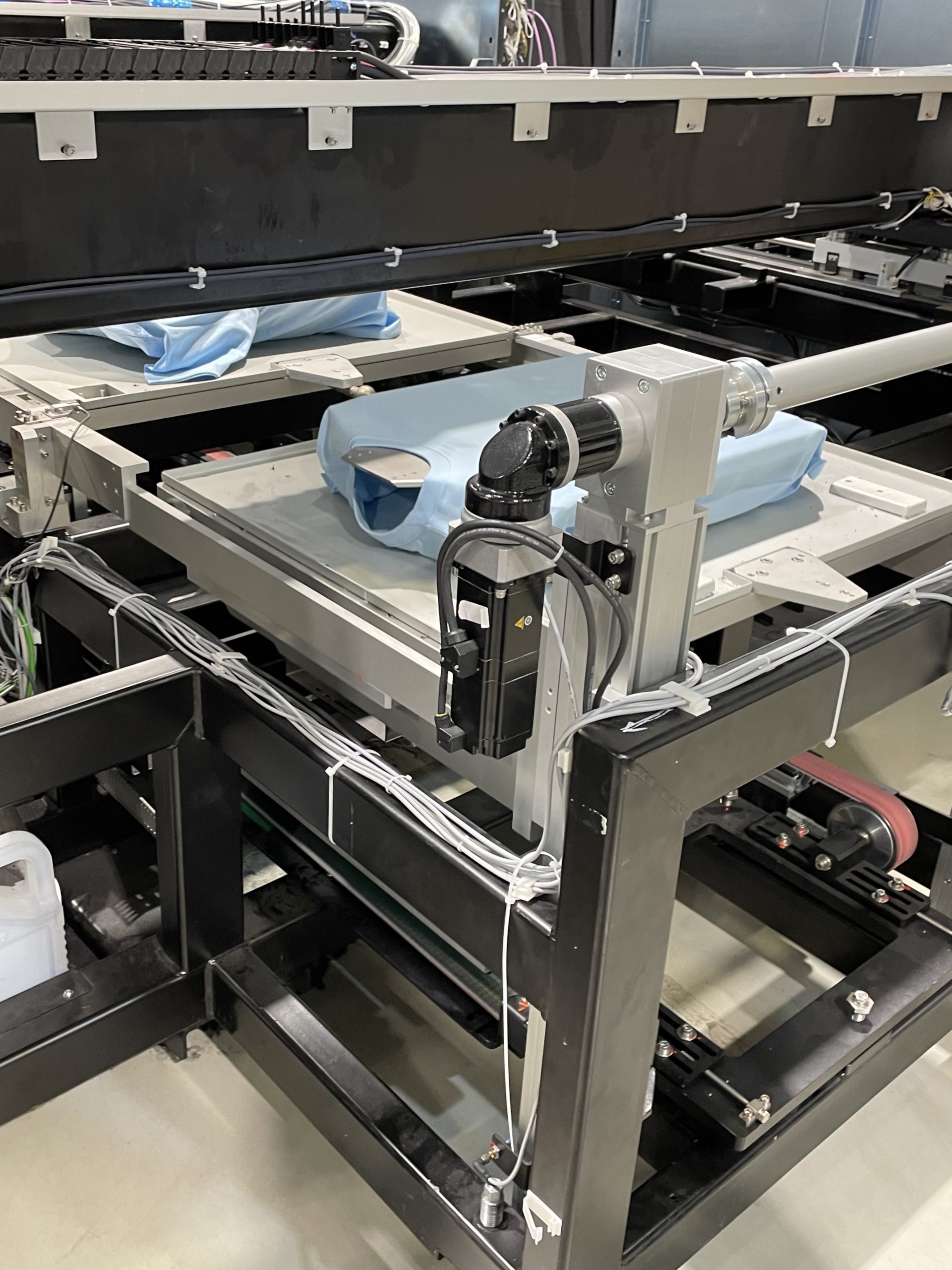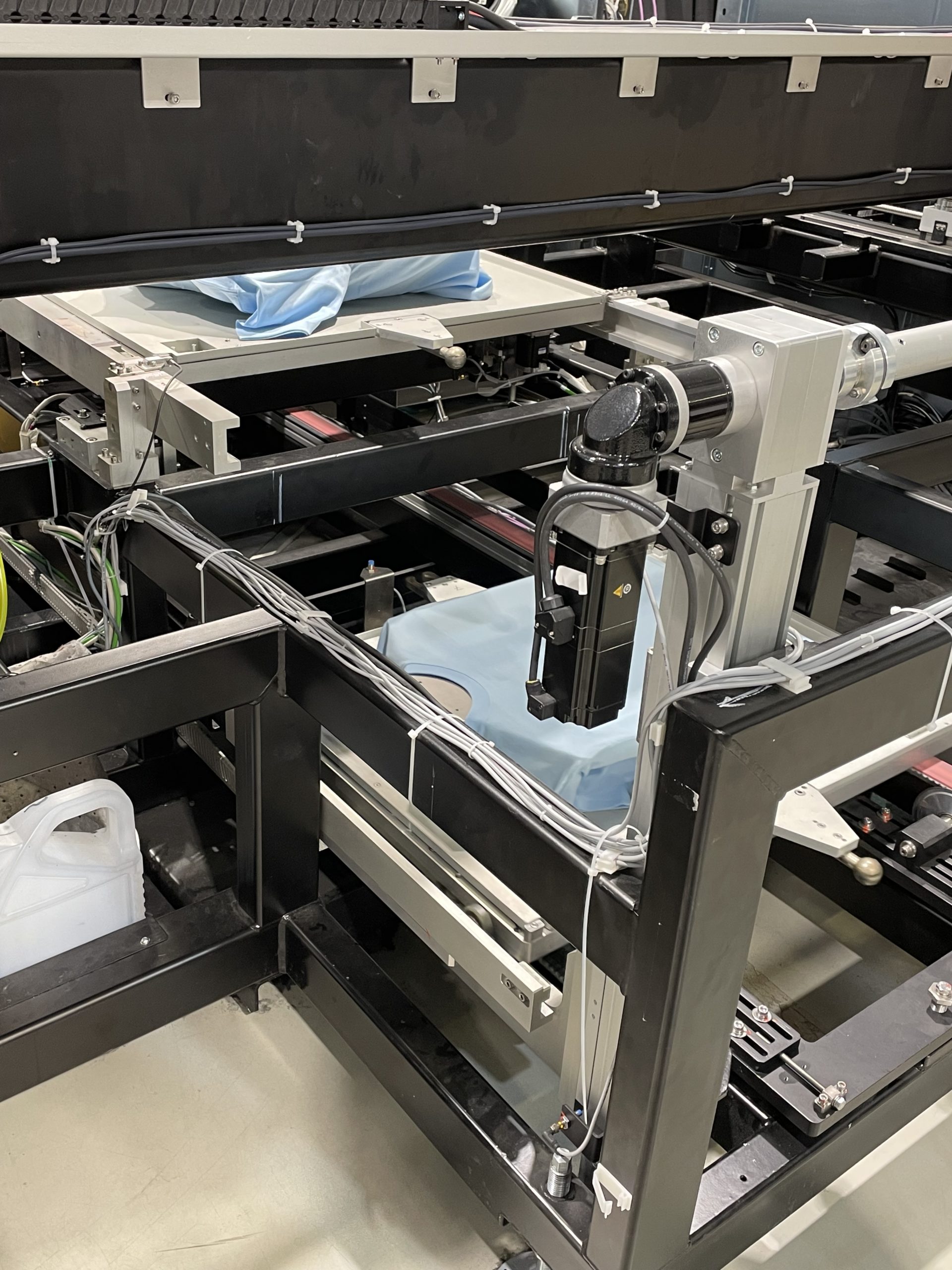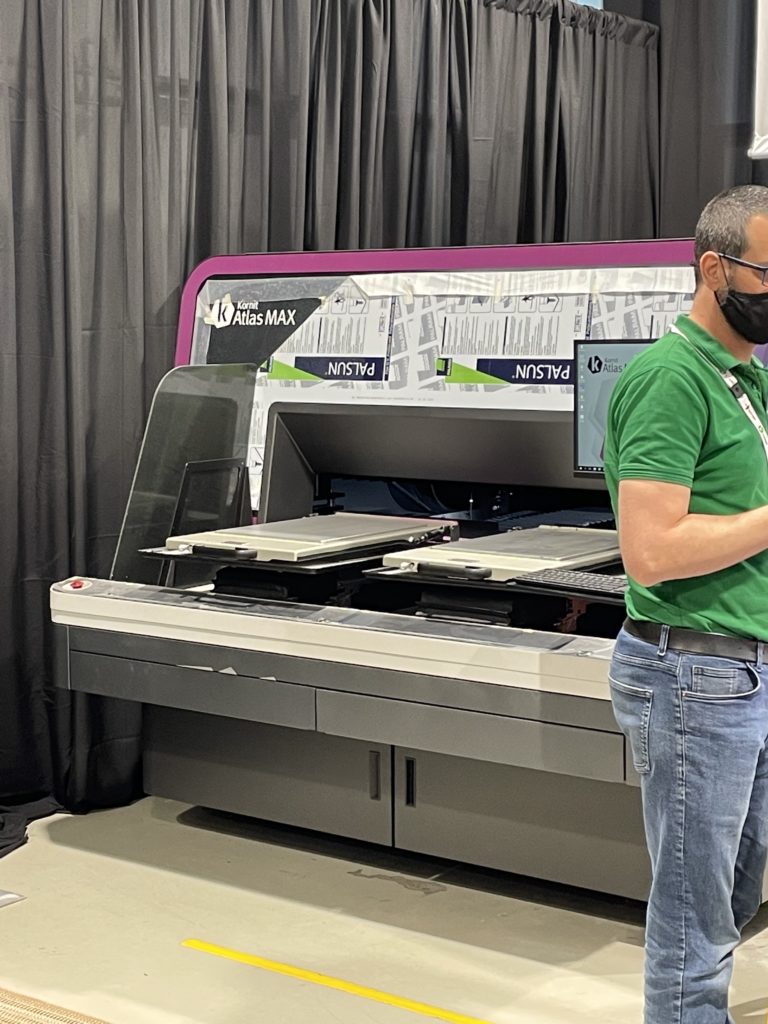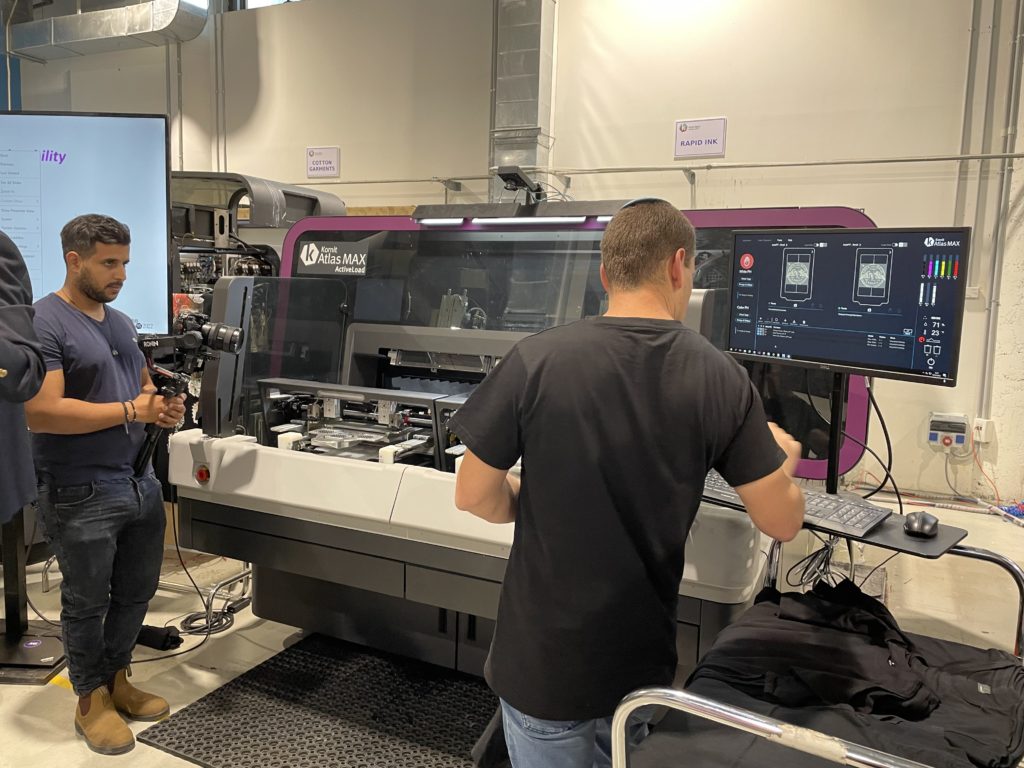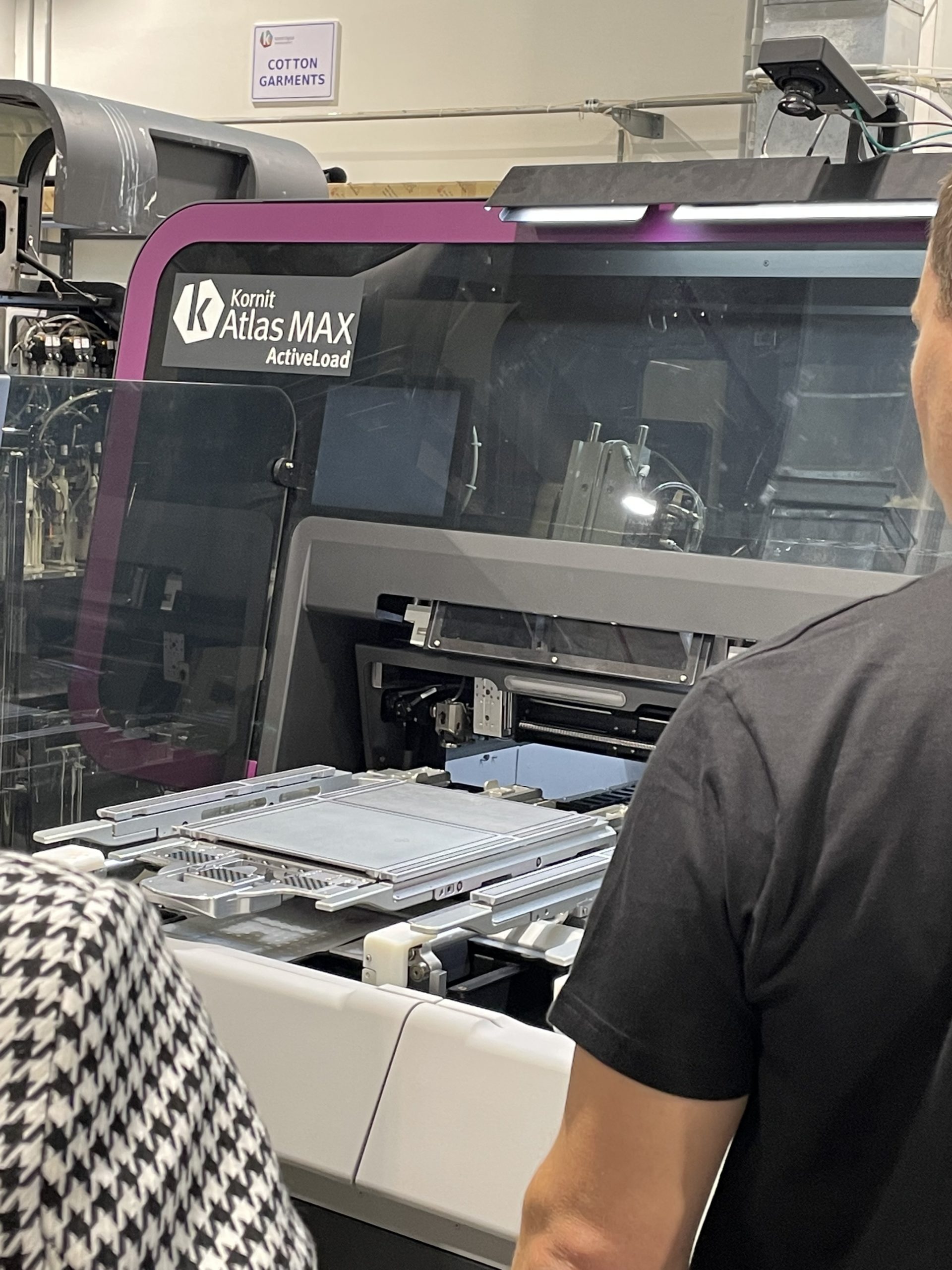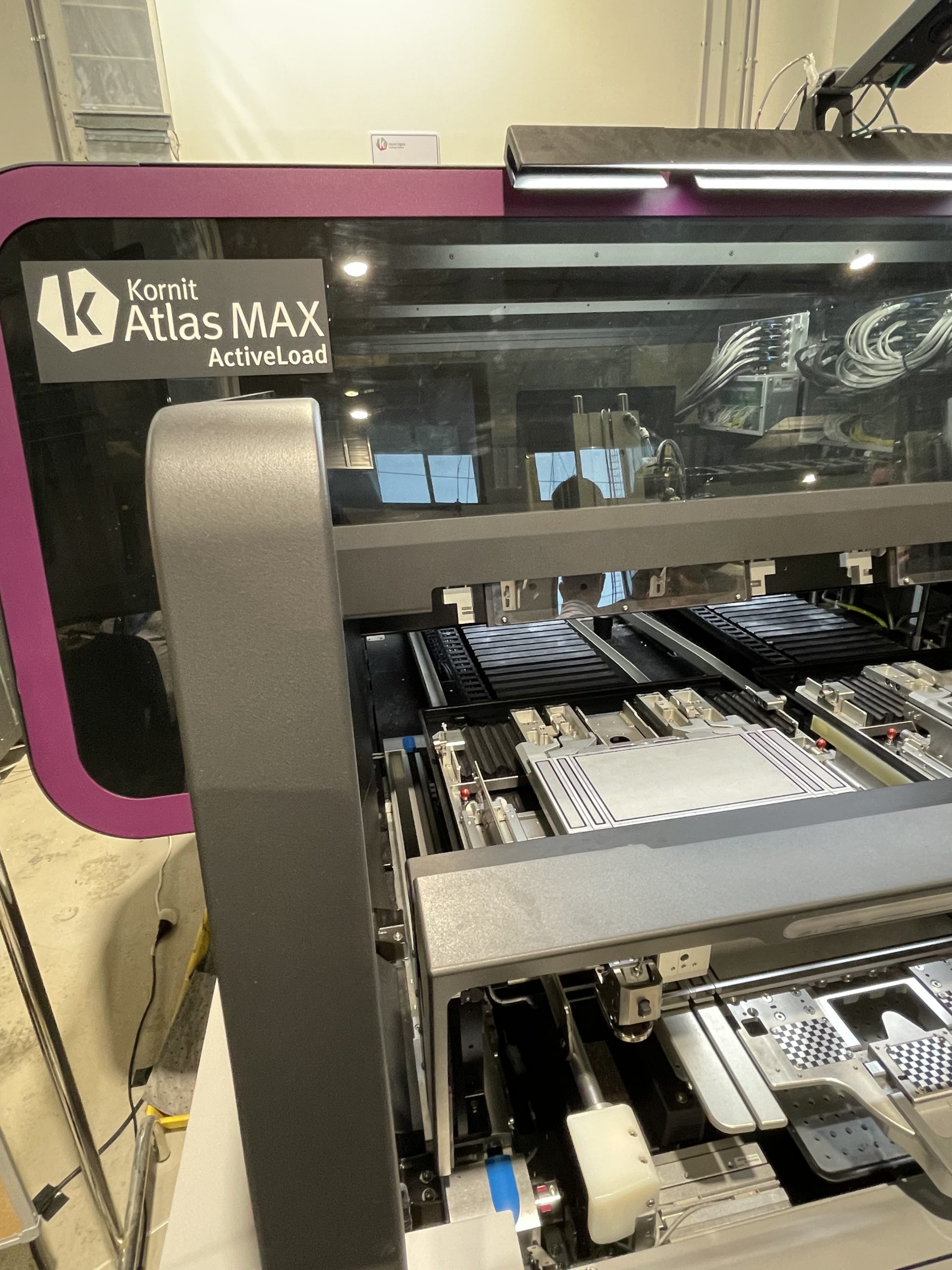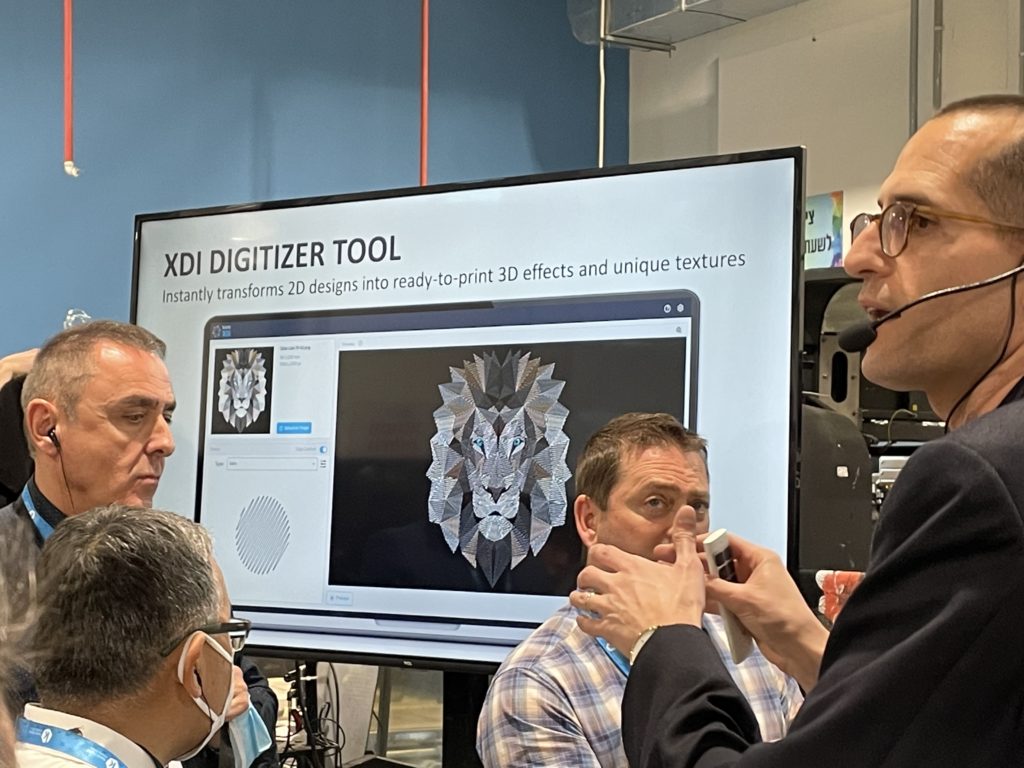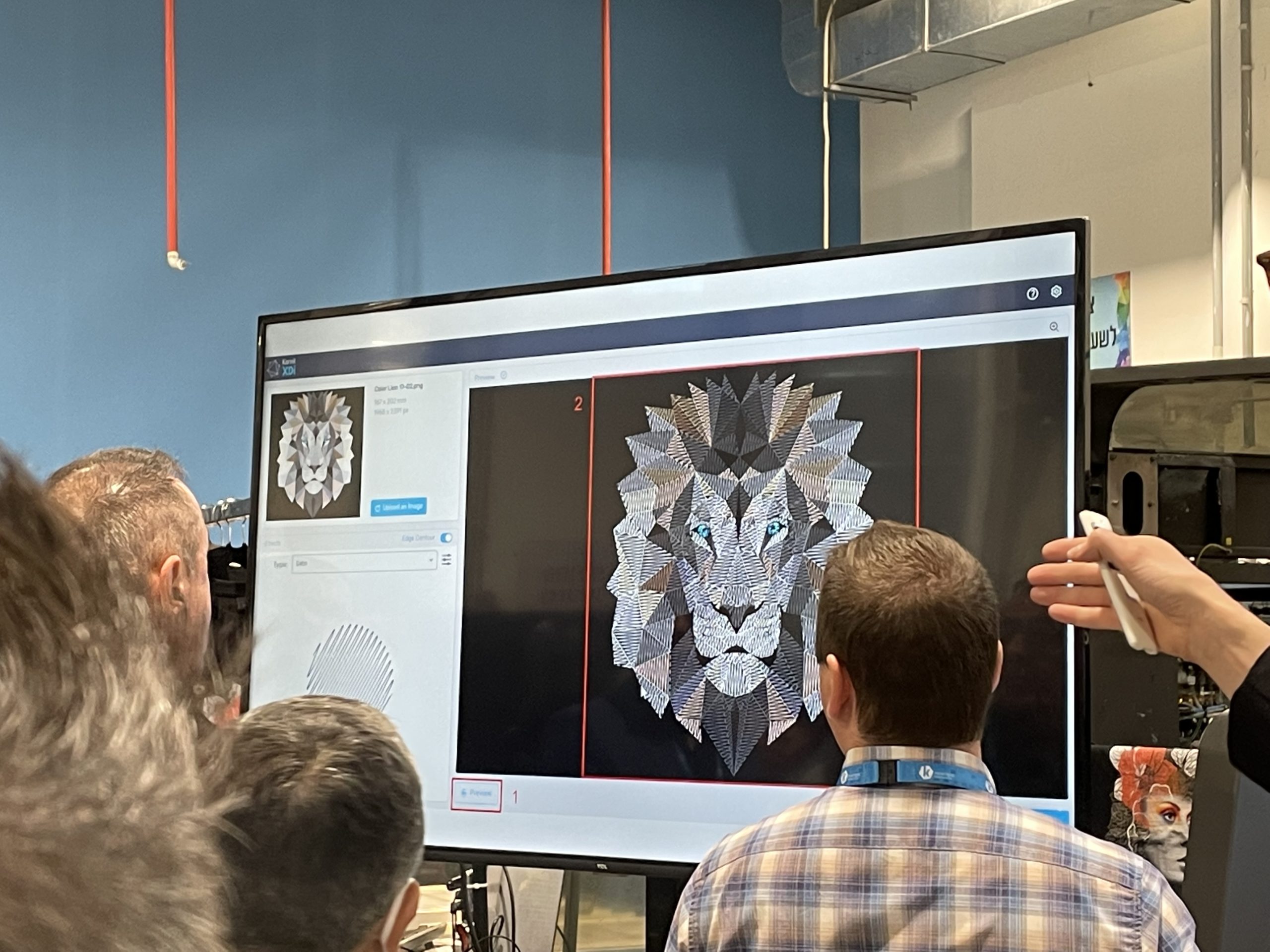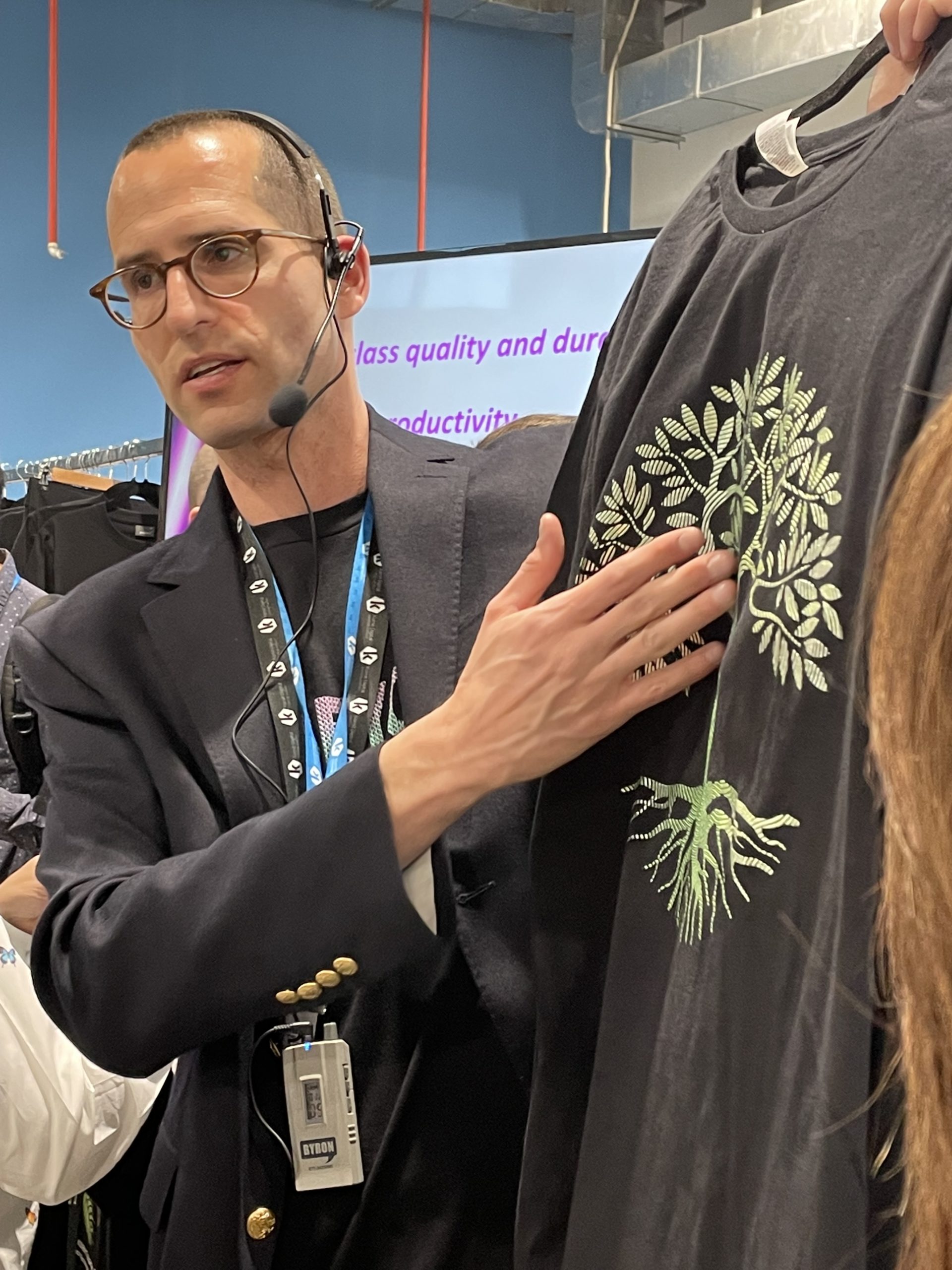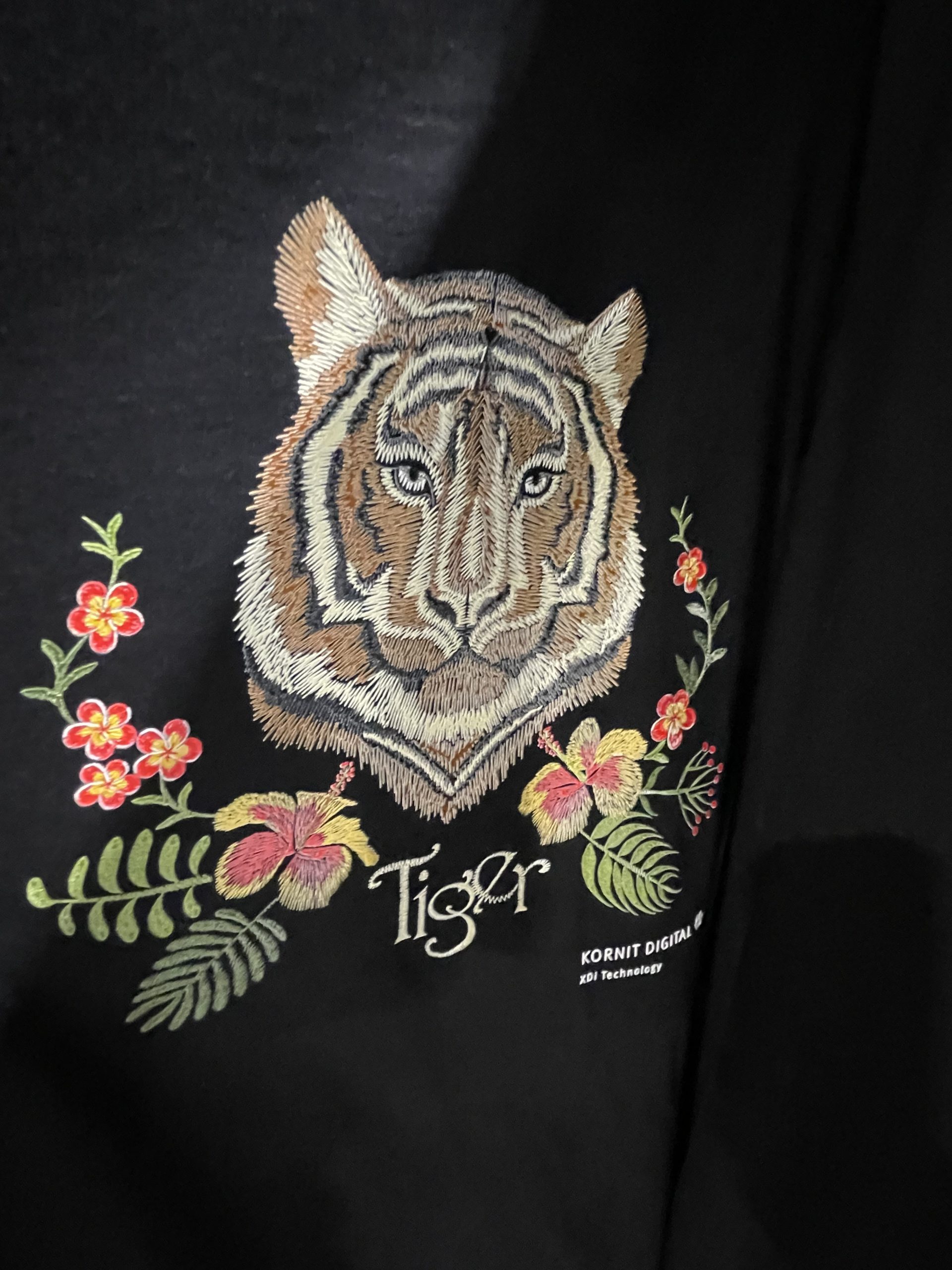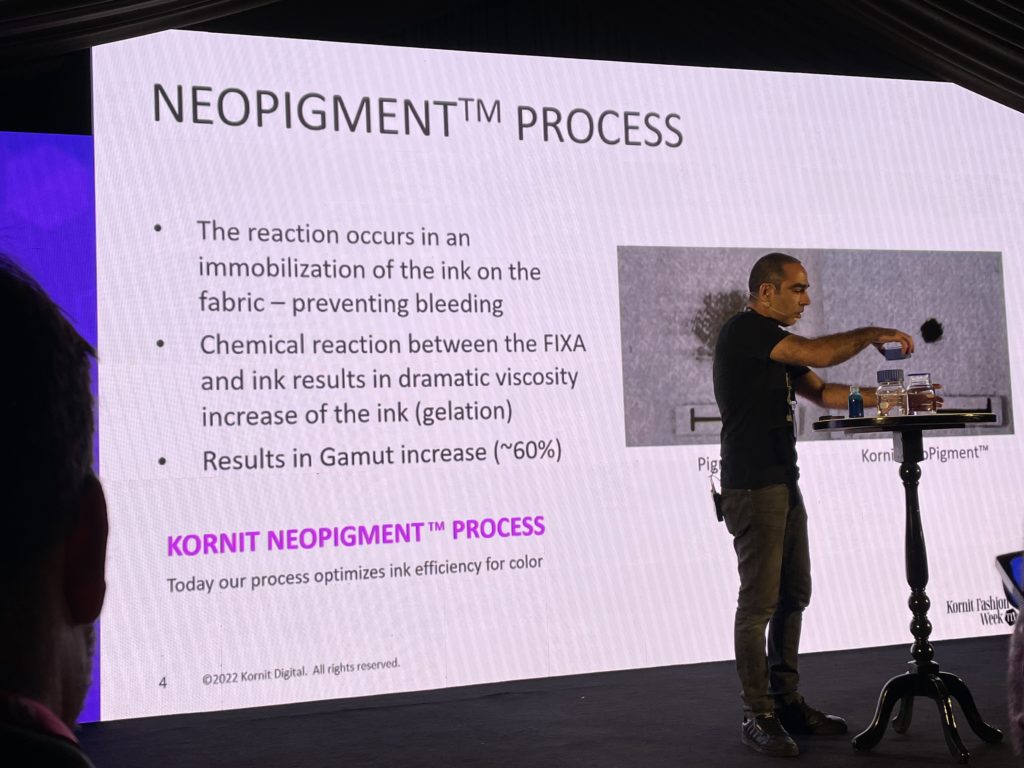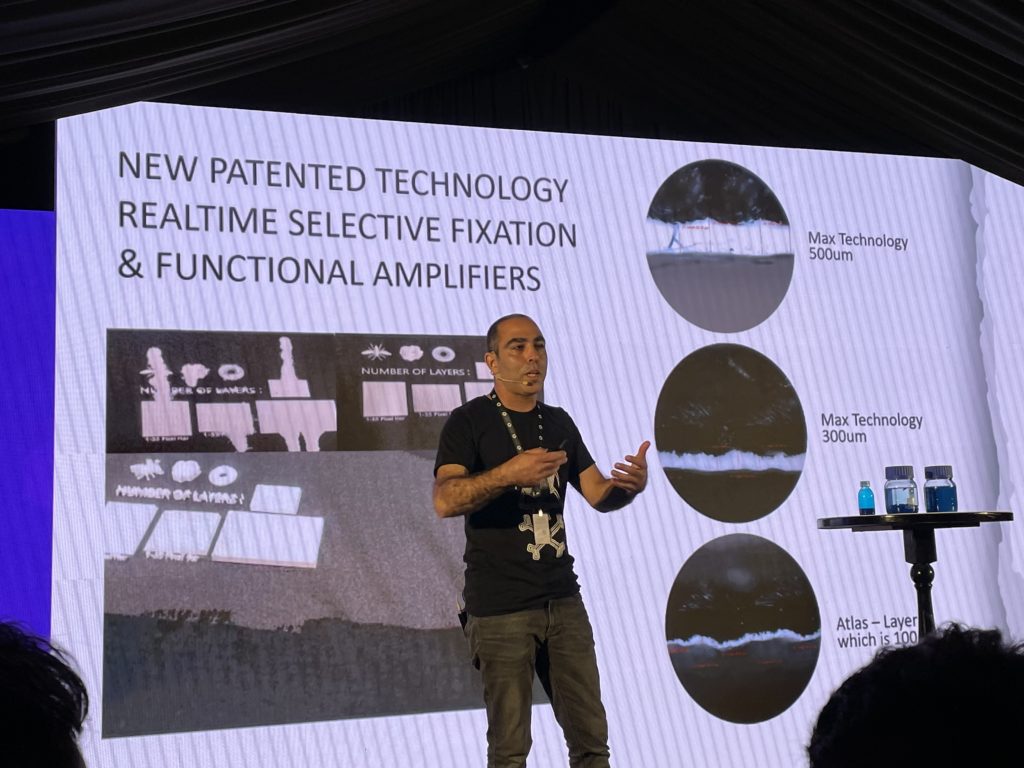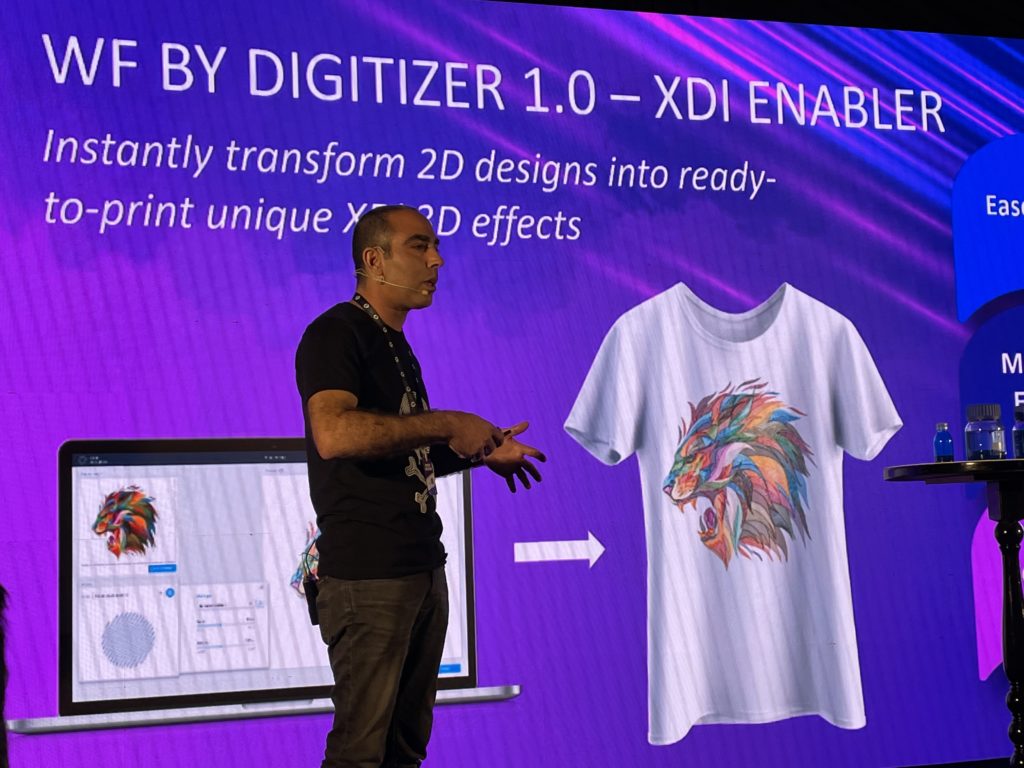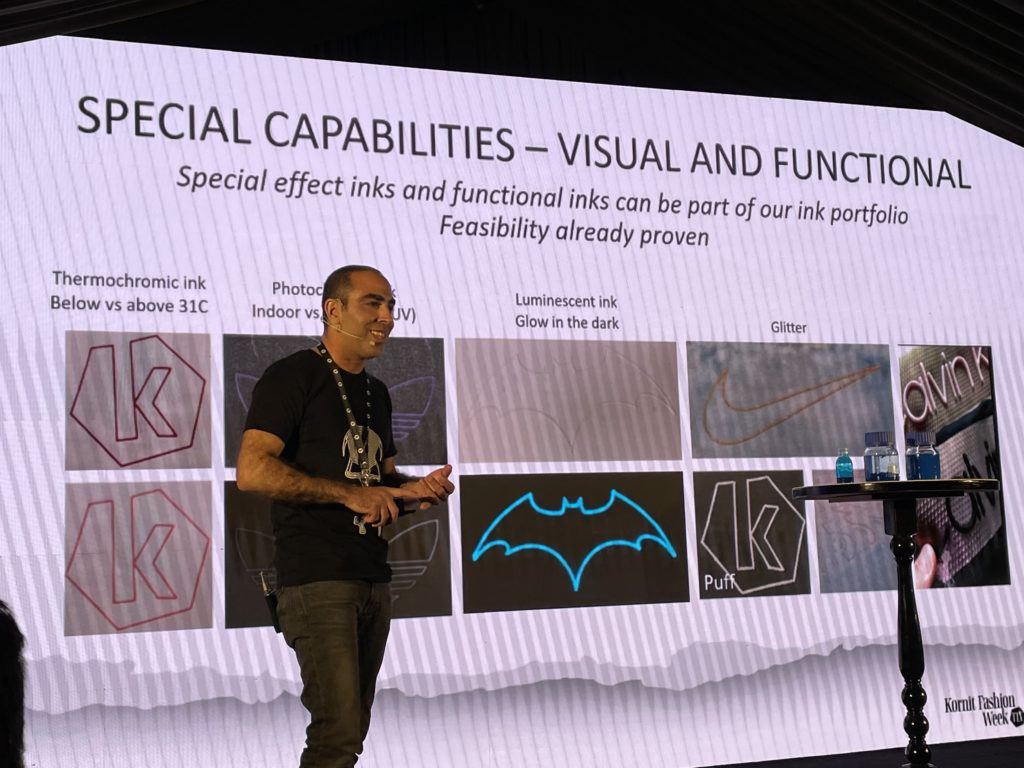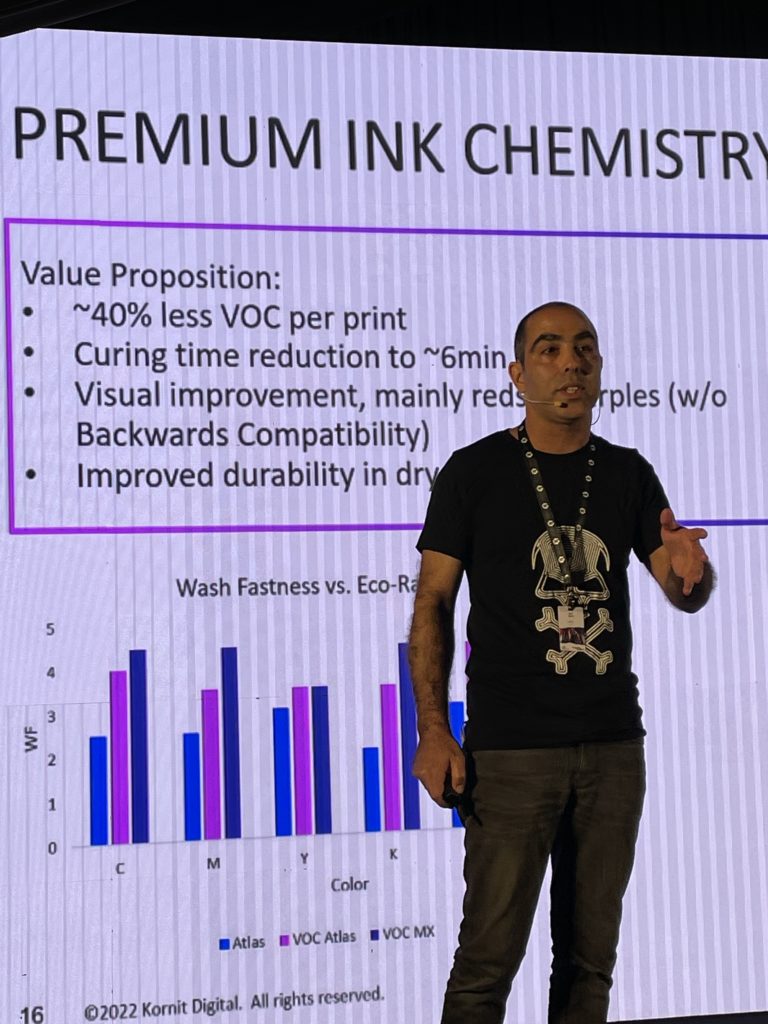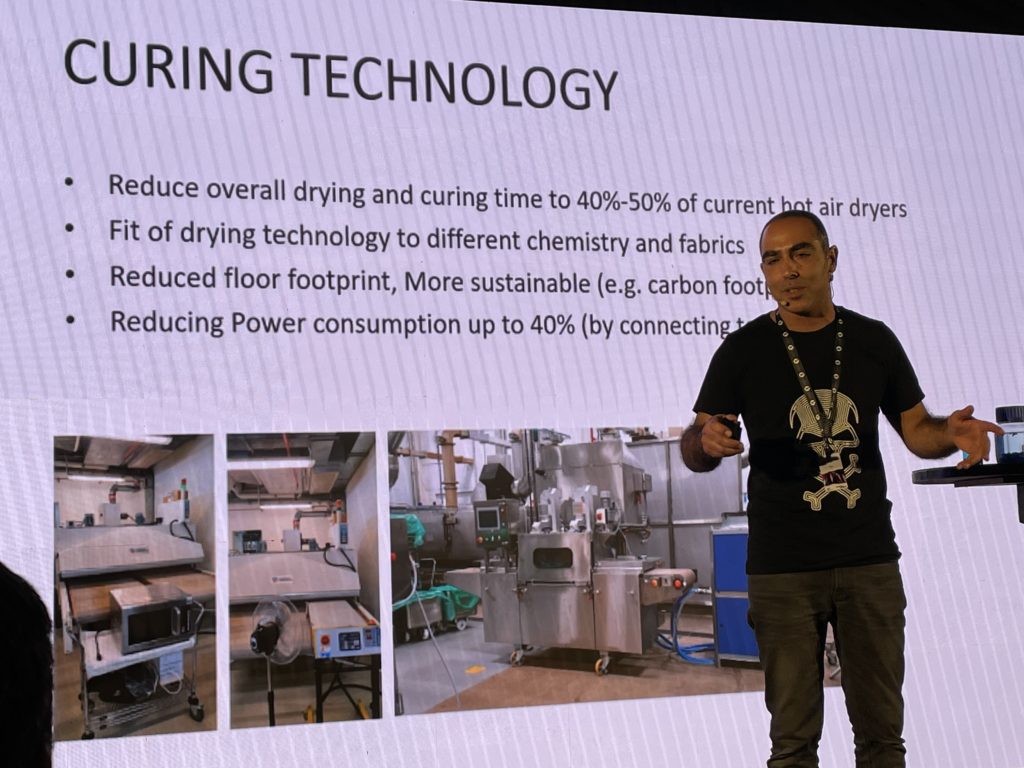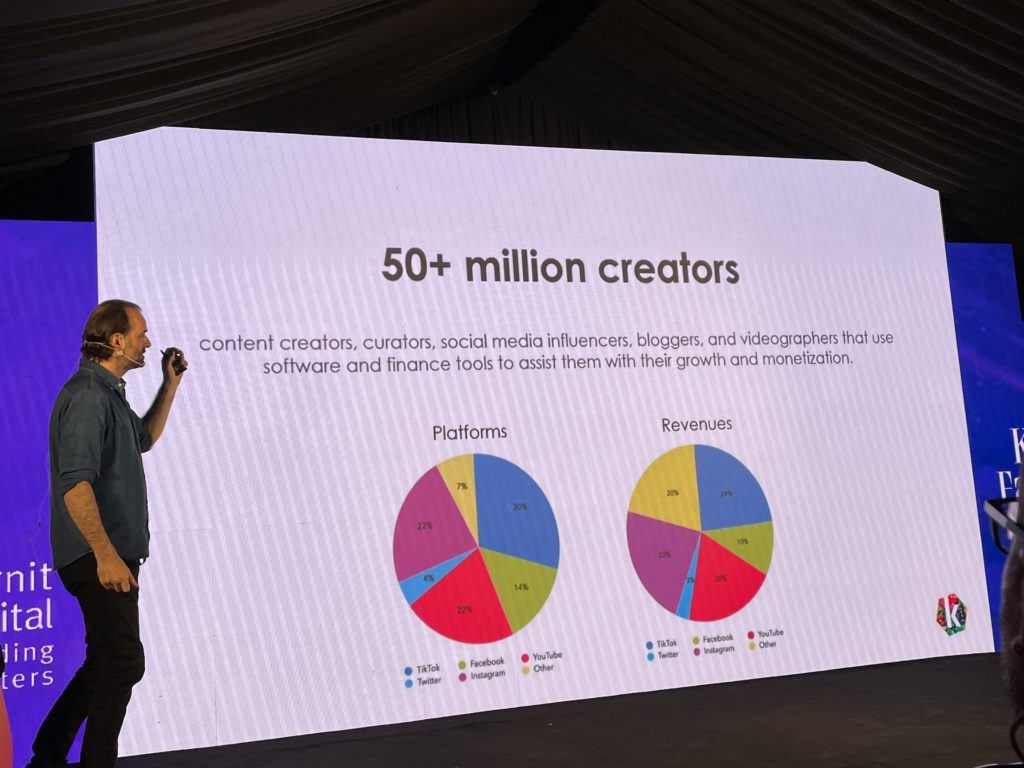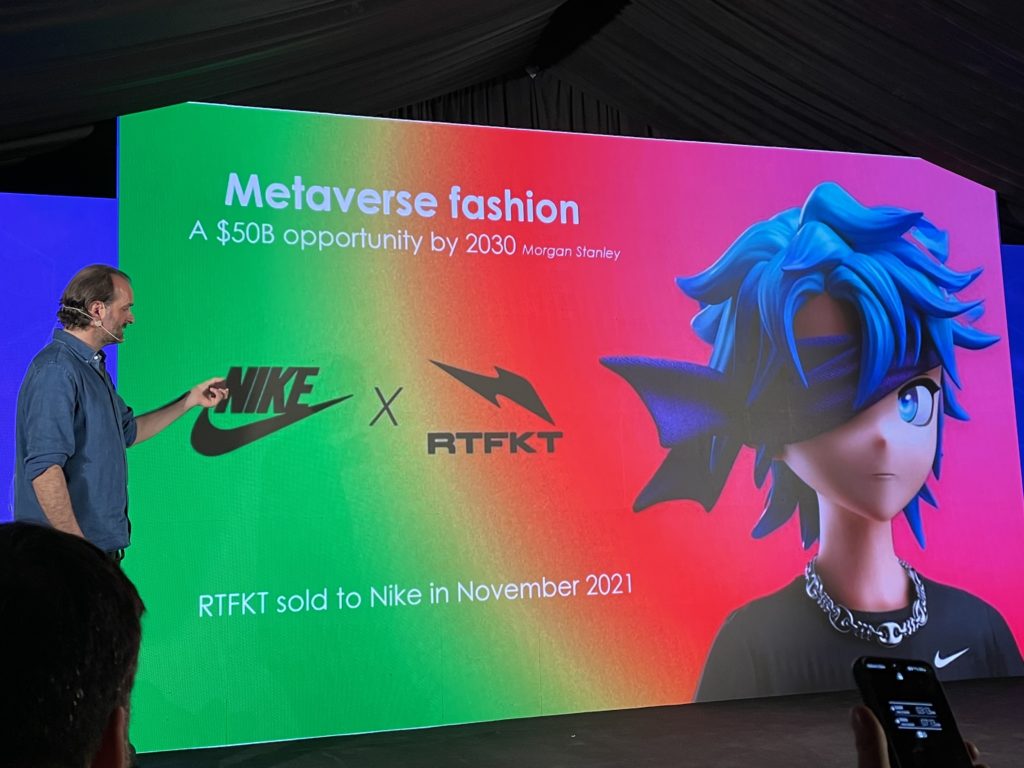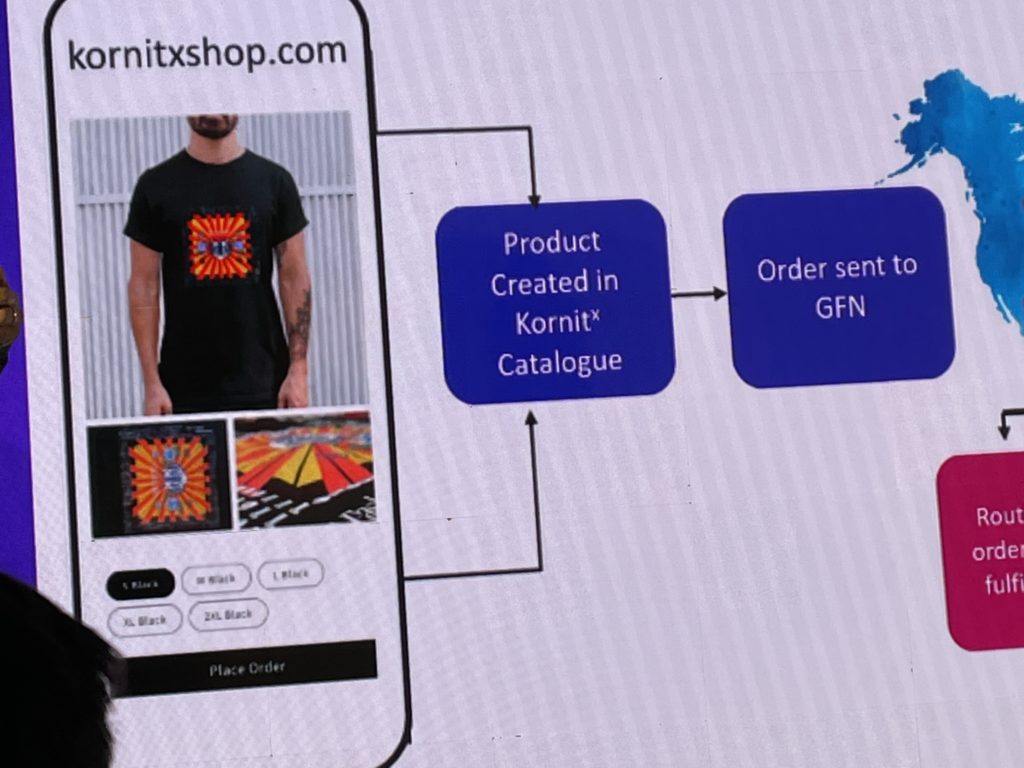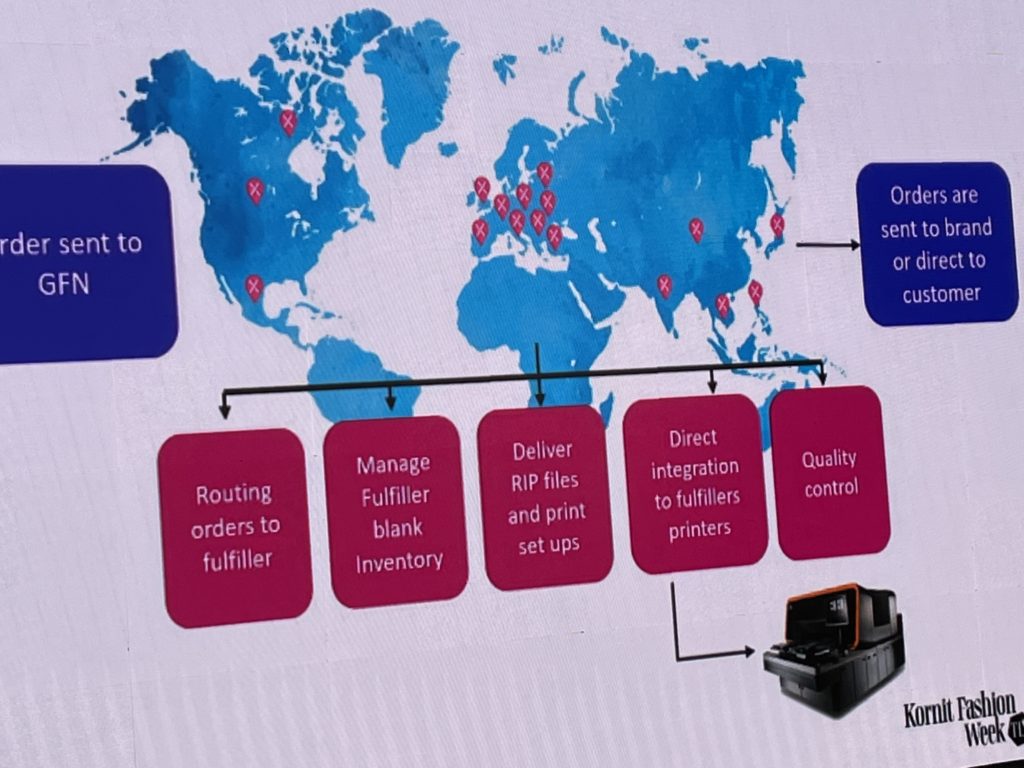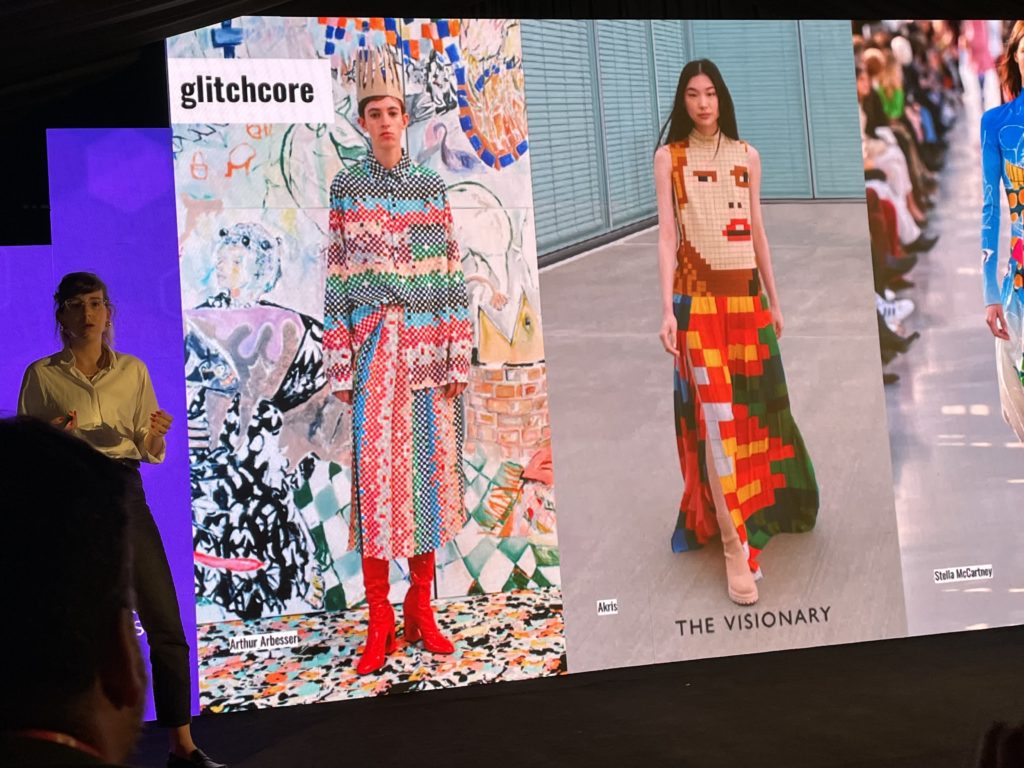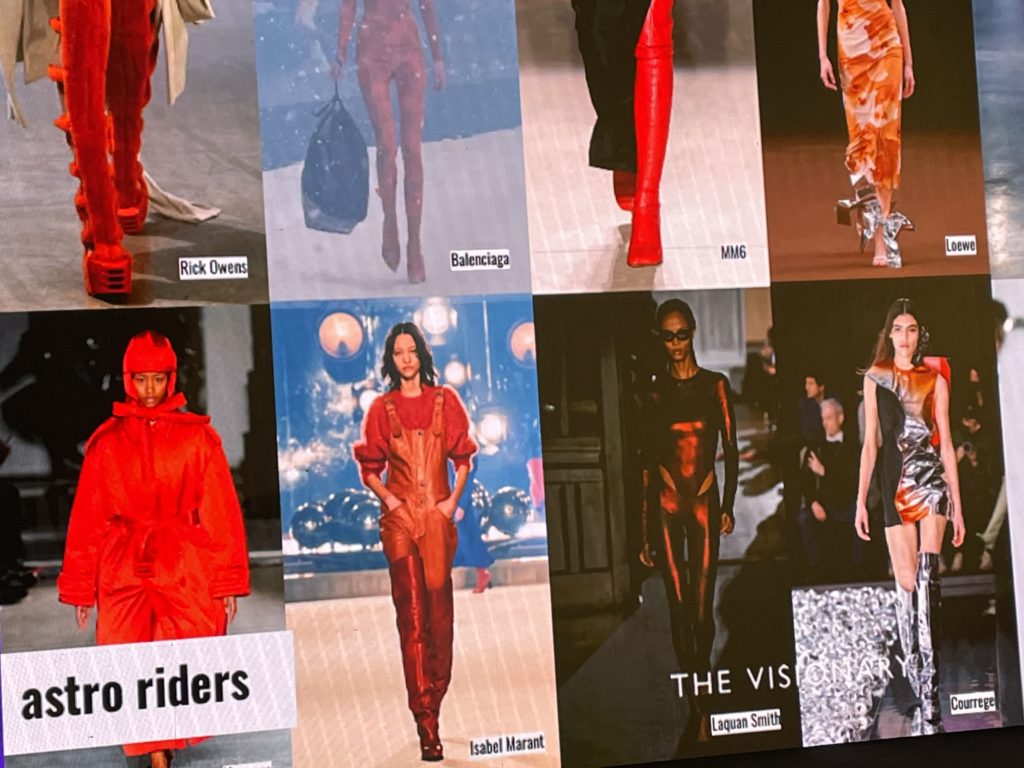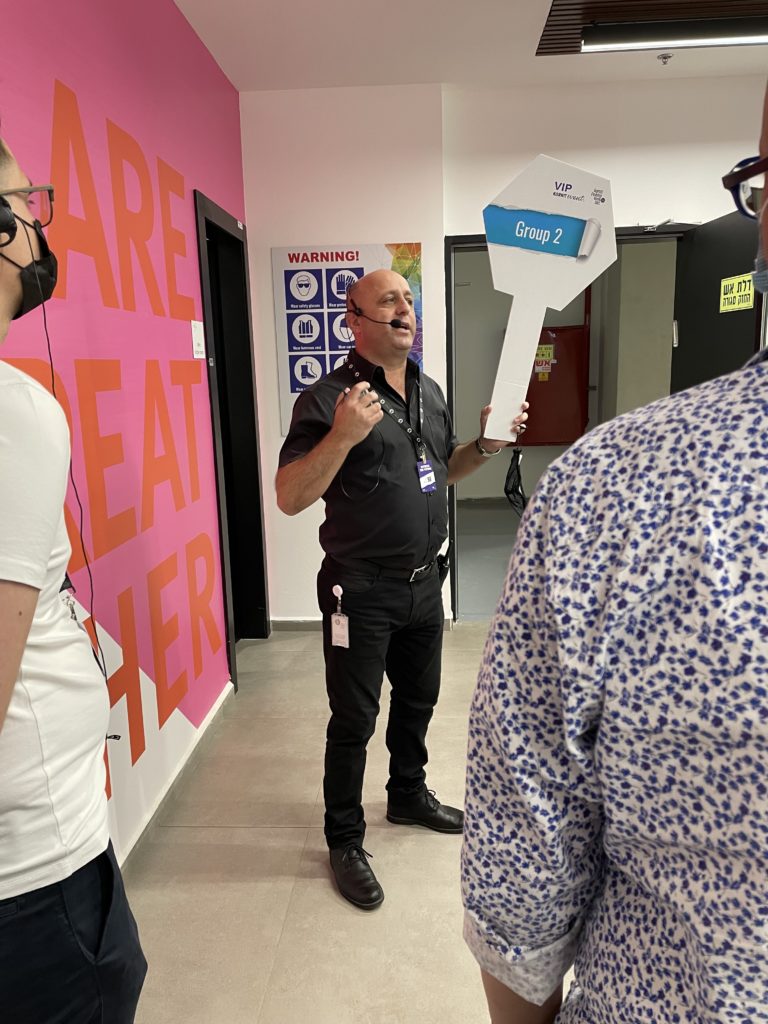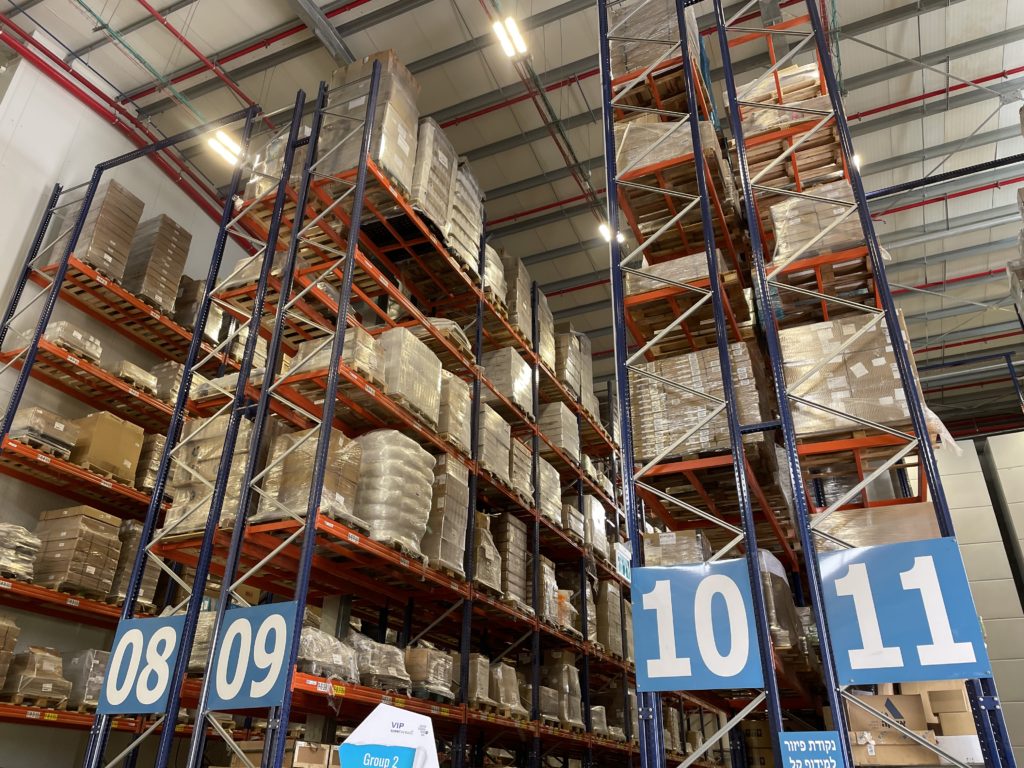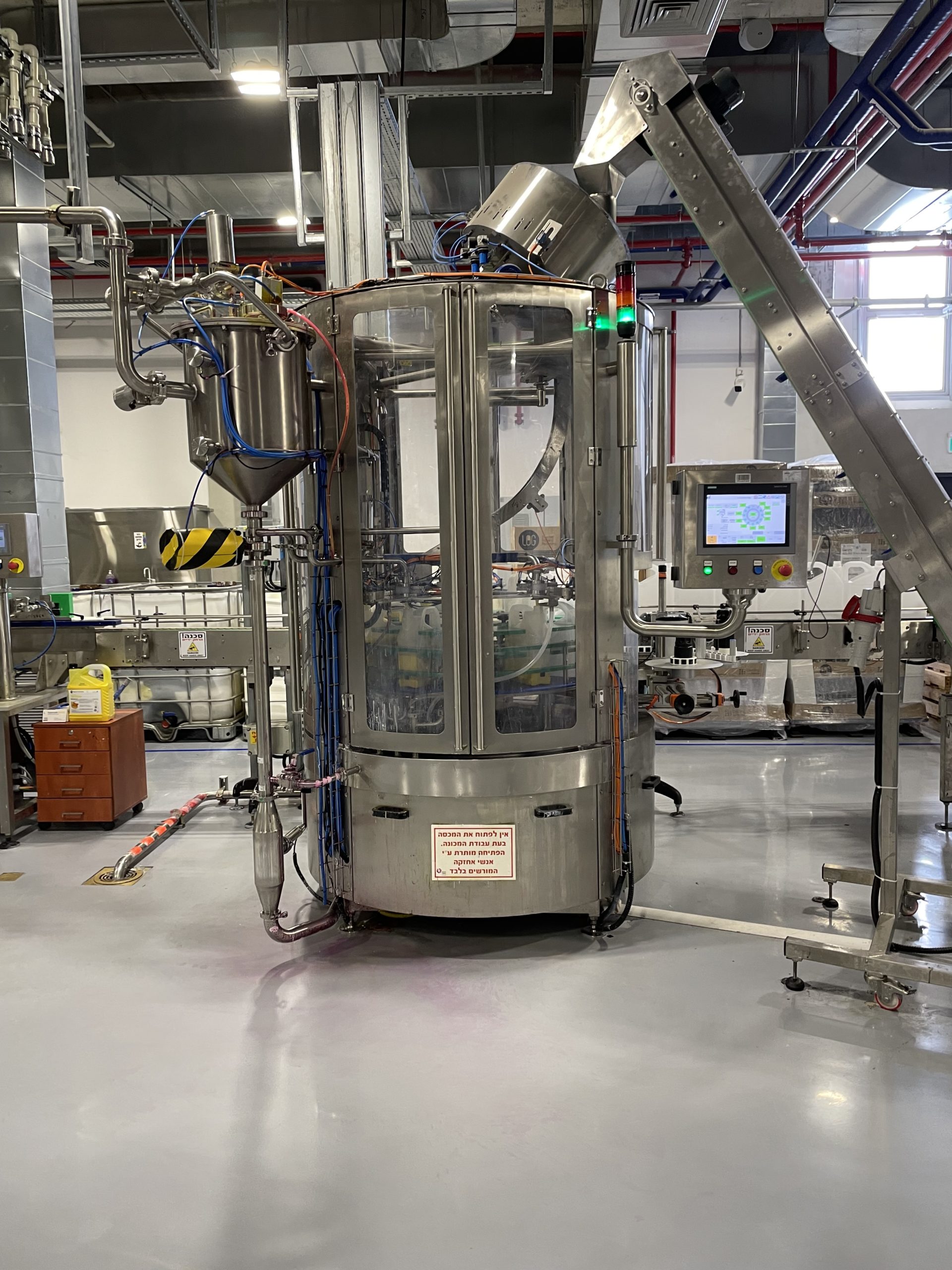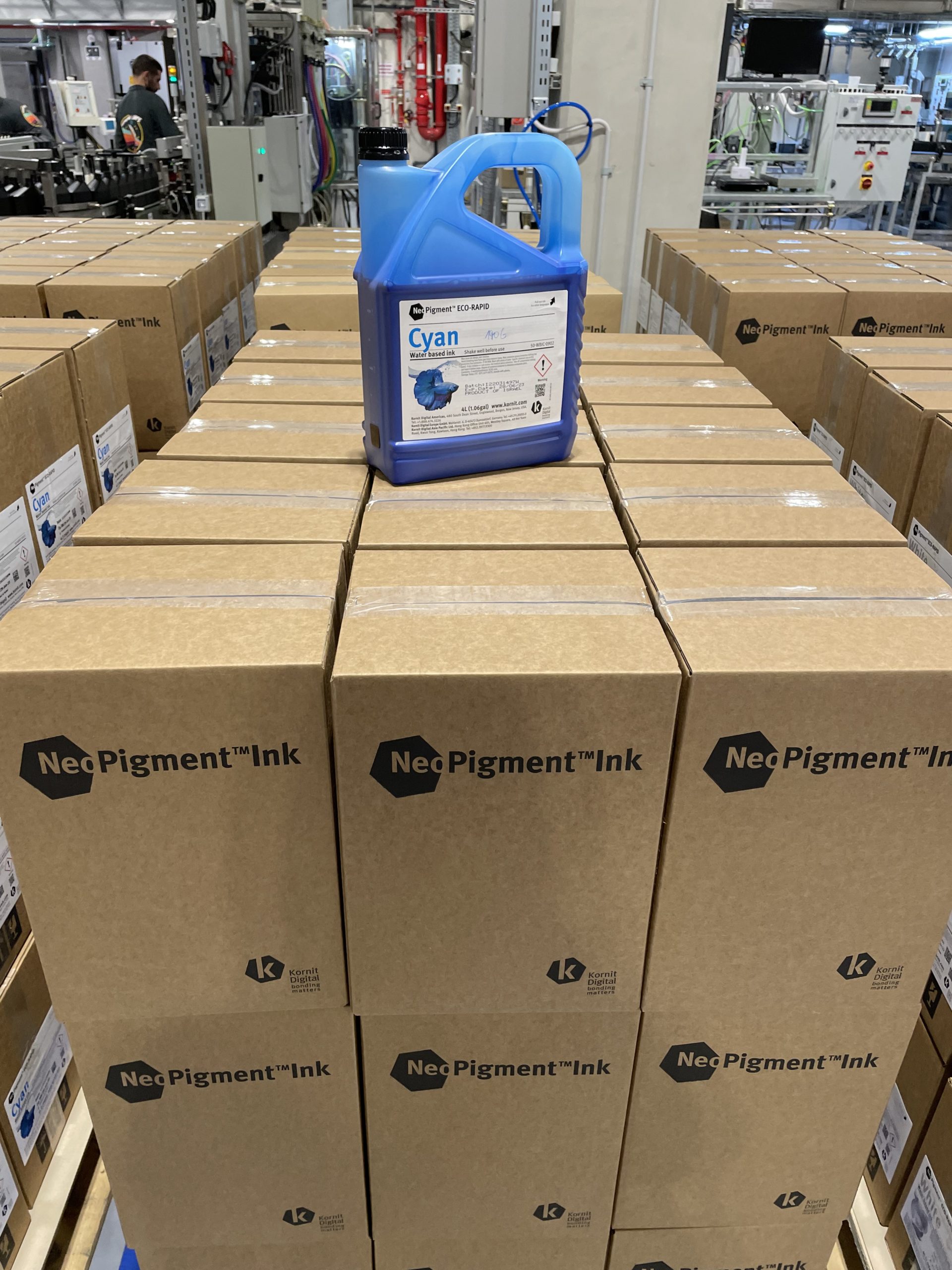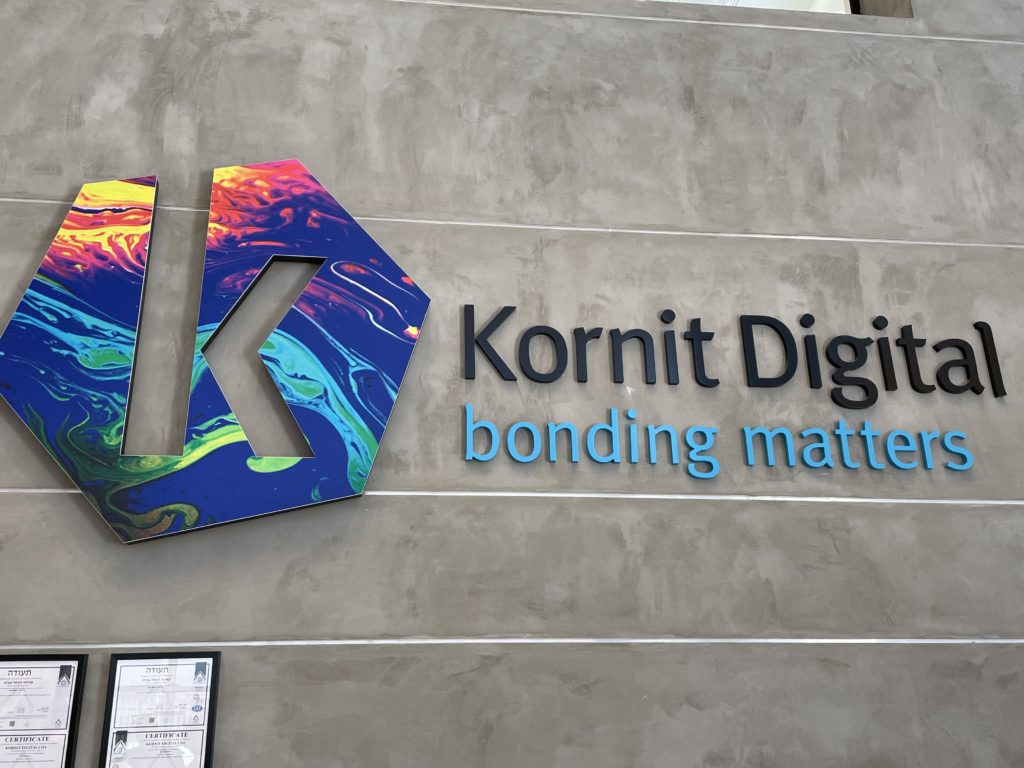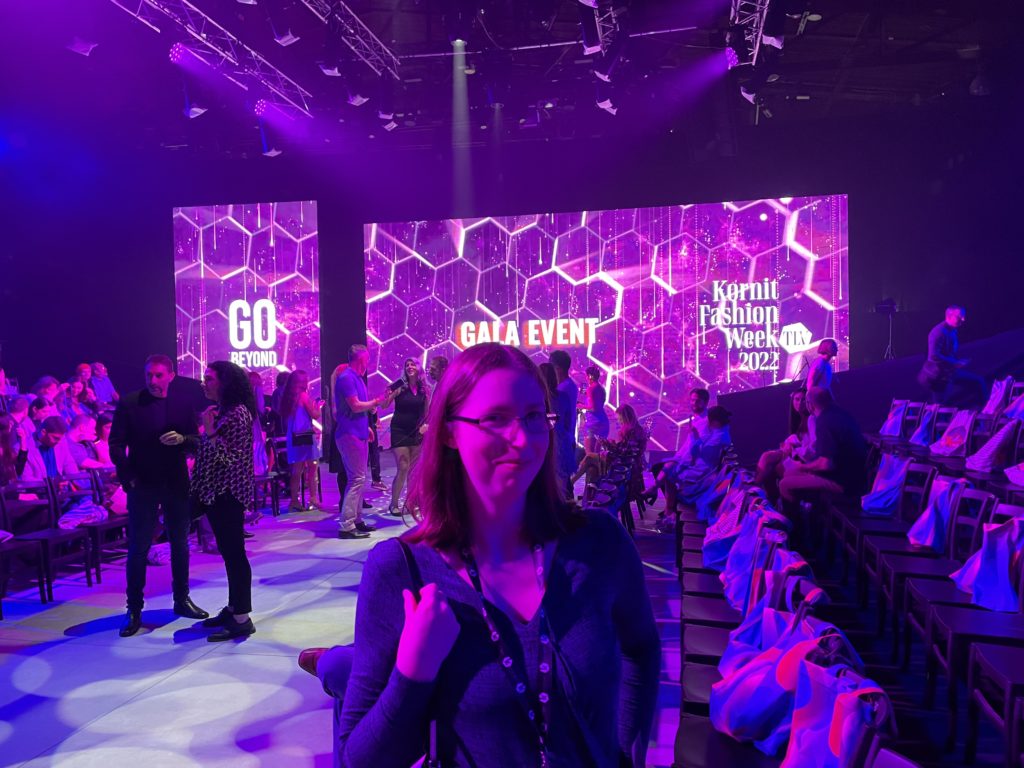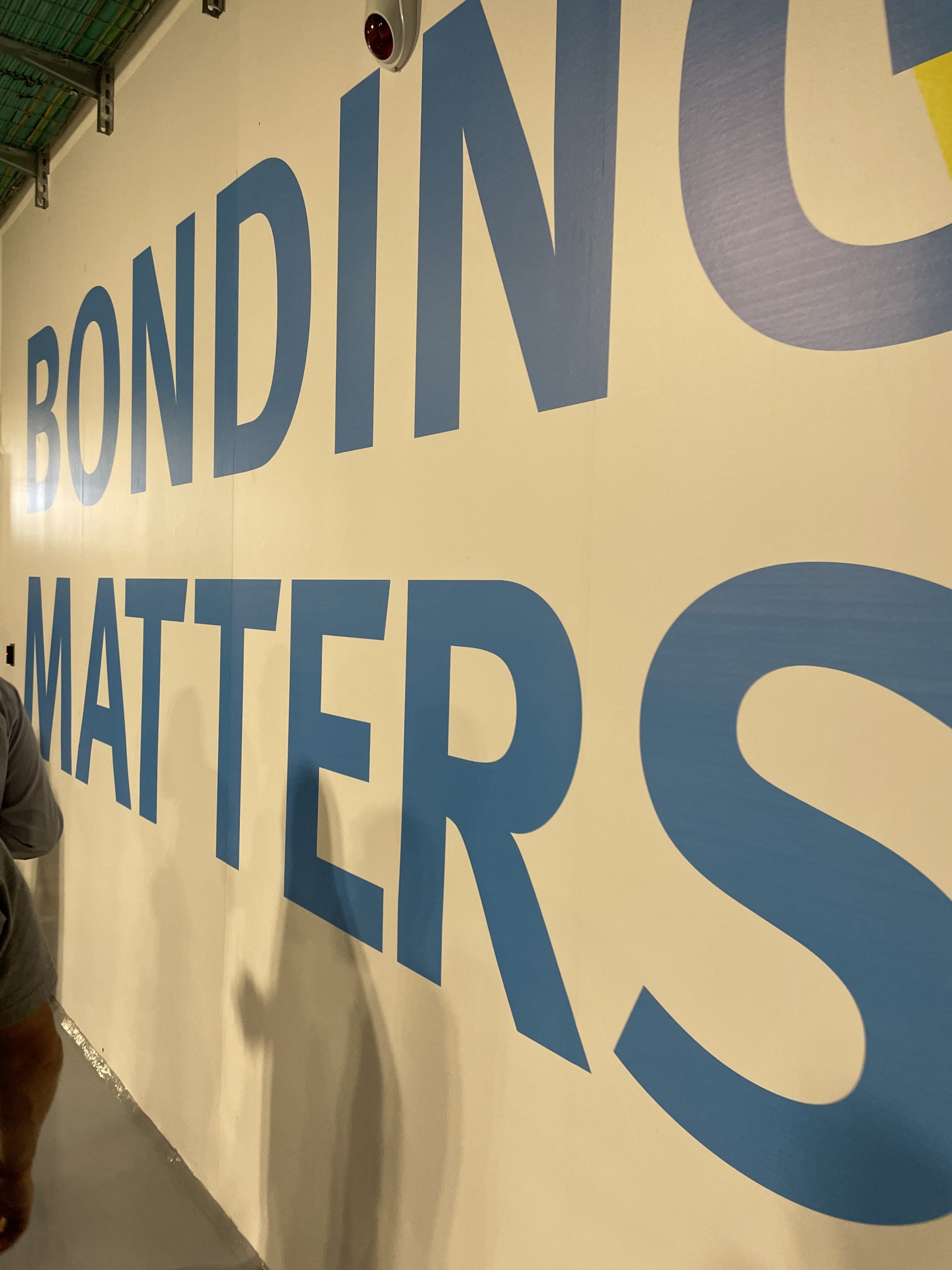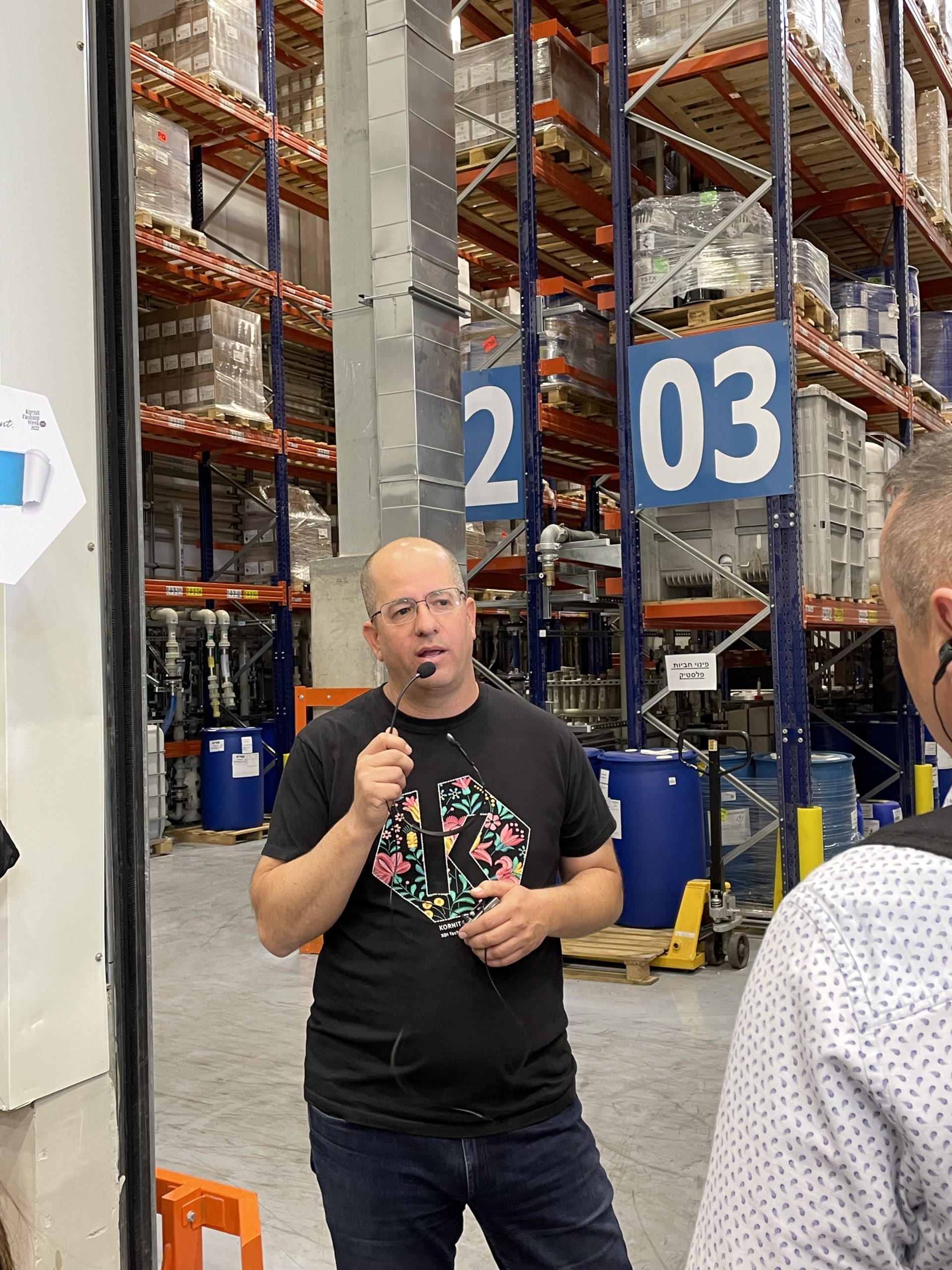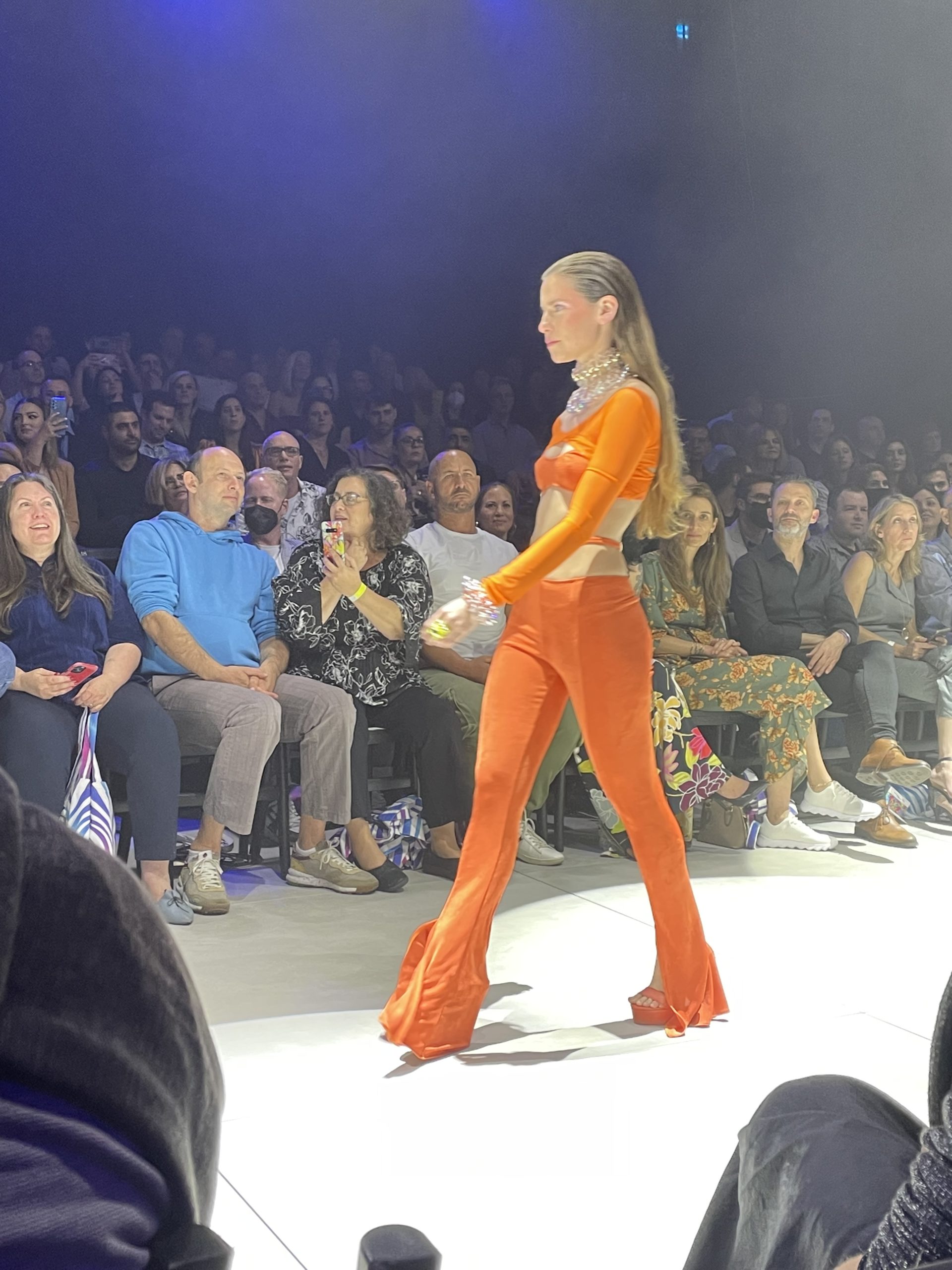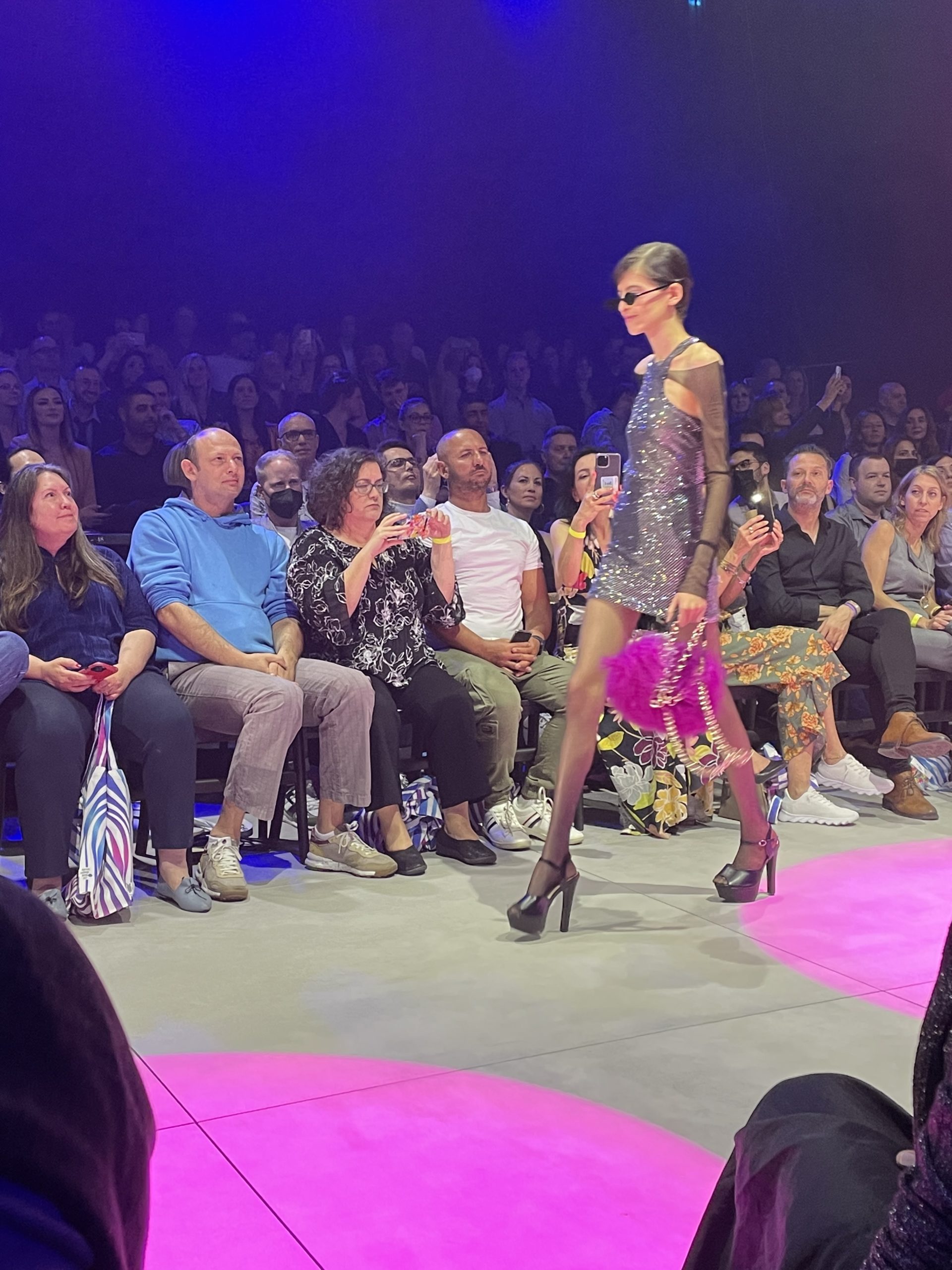I recently traveled to Israel to attend Kornit Fashion Week Tel Aviv 2022 and see Kornit Digital (NASDAQ: KRNT) introduce its Atlas MAX Poly and Apollo solutions for digital, sustainable fashion. The company wants to improve the fashion and textiles industry by reducing waste, but still enabling flexibility and creativity with its on-demand textile production and technology, called direct-to-garment (DTG) printing. Using its XDi effects, Kornit’s MAX technology deposits 3D layers onto fabrics, and the results strongly resemble screen printing and embroidery, though it’s actually an additive process. Kornit also offers a single-step, direct-to-fabric (DTF) printing solution for textiles as well.
The first day, we got to see two exciting fashion shows that were, as CEO Ronen Samuel told the crowd, “based 100% on Kornit’s technology.” The next morning, we visited Kornit’s nearby headquarters for a day of presentations and technology demonstrations, starting with Samuel himself. He explained how harmful the current fashion industry is, and reiterated Kornit’s goals to print textiles more sustainably and efficiently, without compromising on quality; connect the physical world with the virtual one; connect demand to supply; and make the world a better, more inclusive place.
Digital Fashion Changes the World
- Photos courtesy of the author.
After Samuel’s opening presentation, we sat in on a Fashion Experience Panel, featuring Yanky & Nataf—the fashion design duo whose work we’d seen the day before—and inclusive fashion design company Palta, which designed the opening ceremony uniform for the Israeli Paralympic team. In an intro video, Yanky & Nataf stated, “Fashion will not change the world, but the way we make it will.” Both design teams expressed how great it is to be able to produce on-demand using Kornit’s technology.
“Kornit helped us with our design. Everything that we want to do, they help us with a machine. Everything we want to do, we can do instantly,” Nataf Hirshberg said. “Kornit has the insane machines that helps us to make an insane design, and it’s really exciting.”
According to Palta co-founder Netanel Yehuda Halevi, a social activist, motivational speaker, PR specialist, and lifelong wheelchair user due to muscular dystrophy, clothing is the best way to say something about oneself, and “printing is the best way to do this.”
“Think how much you can say for people with disabilities, like people with autism. You can help them say something,” he said, referencing the kind of visual effects possible with Kornit’s digital print technology.
Shay Senior, Palta’s other co-founder, agreed:
“That shirt Ronen showed us—that is the way of independence,” he said about Kornit’s augmented reality textile capability. “Now we can all see how we can buy through a QR code.”
Direct-to-Garment and Additive Textiles
The last session of the morning was about Kornit’s product strategy and presented by Chief Marketing Officer Omer Kulka. He told us that “make better” is the company’s motto, and that Kornit is doing this in a very proactive way.
“We’re trying to make the industry better,” he explained. “Creating a change like this comes from within. To disrupt something, you have to know what it is.”
He explained that Kornit sees “the market and the world around us” as the “front of the house.” These are the demand generators, like consumers and e-commerce, and fashion is accelerating in this digital space. The back end is the pollution generated by the “old production means” of fashion, and Kornit wants to bridge that gap using its tools, including KornitX.
Kulka discussed the company’s new Atlas MAX Poly system, which is described in a press release as “an industry-first direct-to-garment (DTG) solution” that delivers colorful, high-quality digital decorations for design on poly-blended and polyester apparel. Kulka said the company couldn’t penetrate the market before and truly transform analog to digital, but that the durable Atlas MAX Poly is making this possible.
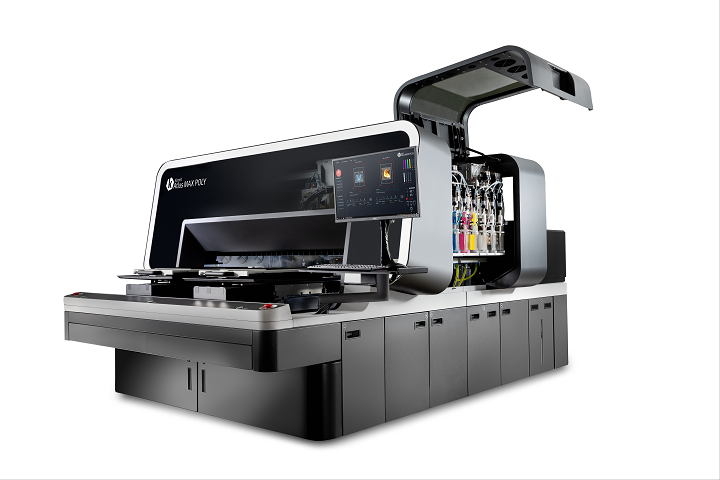 Kornit Atlas MAX Poly is the newest member of the proven Kornit MAX family and the industry’s first for high-volume digital production for vibrant design on polyester and polyester-blended apparel. Photo by Kfir Ziv.
Kornit Atlas MAX Poly is the newest member of the proven Kornit MAX family and the industry’s first for high-volume digital production for vibrant design on polyester and polyester-blended apparel. Photo by Kfir Ziv.He explained that, because Kornit has these digital capabilities, it can penetrate the next generation of applications and verticals, like sportswear and promotional brands. One of the best examples of this is the company’s XDi technology, which enables the printing of embossed 3D textures and prints that look like embroidery and includes heat treatment.
Kulka also said the company is expanding horizontally, and that the vision for “the textile production floor of the future” is lights-out, with no human operators. He noted that automation is a journey, so Kornit is not 100% there yet, but the company will begin to show its soon-to-be-available products for automation through its KornitX pixel to parcel solutions.
He told us that next, we’d see the platforms that run these solutions, like the Presto Max, and the unveiling of the Apollo technology prototype, with its various modules. We’d also see the Atlas MAX Poly, which he called the “next generation of polyester technology.”
“The Atlas MAX Poly has a unique application, and opens up a huge market in pure polyester,” he said. “16% of t-shirts are poly-blend materials. The market is moving there very fast. The pandemic accelerated the merging of poly, athleisure, and fashion.”
Semi-Automated Digital Fashion
It was then time for us to split up into groups for the tour, based on the lanyard color of each attendee. The colors were blue, pink, yellow, and black, or CMYK, a clever take on the model most often used in color printing.
We saw Kornit’s microfactory solution, which features its Presto & Cut textile production workflow, complete with roll to roll printing. This concept has major potential in the AM fashion industry. First, a customer goes online to design and order their custom apparel, then chooses the fabric they want.
The design is then sent to the Presto MAX, which can print white ink on dark fabric, neon colors, and XDi 3D decorative applications in a single-step process. The employee explaining the technique noted that this solution is far more sustainable than others, with no water input or output.
Color is only printed on areas of the fabric that will be cut, and the remaining fabric scraps are recyclable. Once the garment has been dried on the machine, it’s cut and sorted.
Every step of the way, the operator scans the bar code to ensure they’re creating exactly what the customer asked for, with no mistakes. This dress had two parts printed and cut, details shown by the barcode. This lets the operator know that two pieces need to come off the printer and go to the next station: sewing…not an automated step.
Step six is quality assurance, and once this is finished, the final stage is packing and shipping the garment. Once the bar code is scanned again, the operator gets the customer’s address and prints the shipping label, sending the clothing on to its destination.
We also saw the modules that will make up the digital Kornit Apollo DTG system, which features the company’s MAX technology and textile drying functionality from Tesoma. The system is still in the tech prototyping phase, so the modules aren’t connected yet, but once they are, the Apollo should be able to offer integrated smart curing processes and full automation control in the same platform.
The Apollo system is, according to a press release, “considered a future game-changer for the mainstream mass production of fashion and apparel,” which is a major market opportunity. The company claims it’s the most comprehensive single-step, digital end-to-end system for short and medium nearshore mass production runs. It is also said to offer the “highest output per operator.”
Samuel explained in the press release, “These accelerating shifts to nearshore and short- and medium-run production, in addition to the breakthrough digital advancements we are introducing with Apollo, should allow Kornit to address significantly more of the annual global decorated apparel jobs, generating a multi-billion-dollar opportunity for our customers and partners.”
It was interesting to see the automated process of printing on t-shirts, though again, this was more screen printing than 3D printing.
The Kornit Atlas MAX was in the same room, and we got to see the new ActiveLoad garment loading and real-time pallet adjustment. The company suggests that this automated, patent-pending robotic solution can increase throughput by up to 20% and deliver repeatable, high-quality output with few errors.
The Kornit employee explaining ActiveLoad pointed out that, for most customers, finding skilled labor is a major pain point. That’s why “automation is the key to the future of DTG.” The system is made up of two components: the pallet adjuster, which automatically adjusts based on the size of the shirt placed on it, and the auto-loading mechanism, which pulls the shirt into the machine for printing. A human operator is still needed to place the shirt at the beginning, so the solution isn’t completely automated yet. Regardless, the ActiveLoad enables the Kornit MAX to reach its “full potential” and put out 125 shirts an hour.
Touching Additive Textiles
Then, it was time to see the XDi technology up close and personal. Not only can the new high-volume Atlas MAX Poly print photorealistic and semi-gradient images on dark fabric, but it also uses MAX technology to enable smart, autonomous quality control process automation, and high-quality, additive decorative applications. The results were stunning: multiple design effects on polyester are possible, such as screen transfer emulations, high-density vinyl, threadless embroidery, dye sublimation, and 3D effects—available in neon, no less! Using Kornit’s XDi Digitizer tool, users can transform any 2D design into XDi 3D effects and unique textures.
“We are able to print around 100-120 pieces an hour on this machine. The colors, I must say, are exceptionally good,” said Georg Stricker, Technical Manager with Boender & Beute. “It’s more colorful; the designs are looking more bright and beautiful; and we are now able to print a single layer of white where we used double layers before. You can feel it’s something that is unique in the textile industry.”
Another visitor asked how many layers one of these XDi effects had, and the operator said the system was able to print the six layers in just 40 seconds. There were plenty of shirts available, so everyone had the chance to touch the material, and I was amazed at how much these additive effects looked and felt like embroidery. With XDi, you can achieve complex shapes, all kinds of colors and gradients, and even multiple effects in one print, all while reducing waste, water usage, and energy consumption.
NeoPigment Inks
Our lab tours at an end, we adjourned for a lunch break before the afternoon sessions, which began with Kobi Mann, Kornit’s CTO.
Mann focused on Kornit’s NeoPigment process. He explained that the company’s pigmented ink is a solid particle which is ground up, put into a water-based medium, and then the “floating solid particles” are dispersed. The dispersion process is where the company gets its “unique value proposition,” as it optimizes ink efficiency for color.
The company formulates, tests, and produces the NeoPigment inks itself to ensure the highest possible quality, and claims they’re the “safest way to print.” According to Kornit, the water-based inks are 100% toxin-free and non-hazardous, don’t contain any animal by-products, and meet important safety applications.
Mann told us that material chemistries are the ‘fundamentals” of the process, and that Kornit is currently focusing on acrylic, silicone, and polyurethane. He also said Kornit is working on physical adhesion, as well as creating a chemical reaction with the fabric. By improving the chemistries, you can control the solution by making them stronger, which takes you into further applications.
Adding Layers to Digital Fashion
Kornit’s patented technology revolves around real-time selective fixation and functional amplifiers. As Mann explained, XDi enables the building of layers on top of layers, and while it’s not quite ready to go to market, “the fundamentals are there to take it from 2D to 3D space.” Polyester screen printing is usually pretty heavy, but Kornit’s technology can create more lightweight layers on shirts. Mann said the shirt he was wearing featured 1.4 mm layers—about the same as puffy paint. The applications include screen printing, heat transfer, and the vinyl look.
“XDi enables ease of use, multiple effects, and is process-certified,” Mann said. “It’s a tool for the workflow.”
The solution can also help in pursuing new applications and leveraging business cases. He explained that there are many different types of stitches, but XDi can make the three most commonly used in embroidery, including counter stitch and step stitch. In addition to functional inks, XDi also enables special effect inks, such as glitter and luminescent.
“So how can Kornit transform this industry to pure digital?” Mann asked. “We started some ideations, which is why we acquired additive manufacturing companies, so we can use complementary technology to transform the market into decoration. Our hybrid equipment can bridge all the different equipment that’s out there.”
Mann told the room that Kornit is “polluting in a sense,” but still has a goal for the future to decrease its waste and usage of energy and water, and minimize how many harmful chemicals it uses. Specifically, Kornit is looking to lower its VOC usage by 40%.
He said Kornit’s hybrid printing solution will “enable reduced curing time by half,” which will also help reduce energy. Additionally, the electricity saving for the company’s next-generation dryers is about 40%.
Moving at the Speed of Culture
Next, Bobby Sims, a serial founder of companies who works as a strategic advisor to big brands like Coca Cola and H&M, talked about “Moving at the Speed of Culture.”
Sims said while we may think we’re “still in the internet era,” post-COVID we’re actually in a culture and creativity era, as everyone is becoming a creator. He said that clothing is now the highest priority for Gen Z teenagers, as opposed to food. This is obviously good news for companies like Kornit.
Major takeaways from this presentation include the move from Web 2.0, which Sims called a “flat system” that connected people and platforms, to the spatial Web 3.0, which connects people to digital spaces and assets, like NFTs. For example, he said the first digital dress sold at the end of 2021 for $9,500, and that 108,000 attendees—including Versace—were at the Metaverse Fashion Week by Decentraland, which focuses on skins for avatars. Sims said creators are driving this change to the “digitization of everything,” but that instead of being creator-powered, where influencers help sell products, it’s more creator-led, “where the industry provides access to the supply chain.”
Transforming the Supply Chain
Next up was Aaron Yanelli, President of KornitX, which gives stakeholders the tools they need to generate more revenue and digitally transform the supply chain.
Yanelli said that on-demand manufacturing will “change the world for the better,” and that Kornit is addressing the demand for this by reducing over-production, opening new revenue streams, enabling smart routing to its Global Fulfillment Network (GFN), and leveraging social media with direct purchase links for a better customer experience.
“Everywhere we go is an opportunity for commerce,” he said.
He brought up a couple of case studies, the first of which was with retailer Next. Yanelli explained that Next wanted to move faster, while also creating a better customer experience and saving money, and that Kornit is the retailer’s virtual warehouse. Through its integration, Kornit introduced personalization to Next, so customers can go in and customize what they want.
The second case study was with the Hut Group (THG), a British e-commerce retailer that operates over 100 international websites, bringing brands directly to the consumer through its platform. Yanelli said THG found Kornit because it was looking for an end-to-end workflow solution, and “thought ours was better than anything else.” He explained that KornitX is a full-fledged software platform with “hundreds of different solutions and mechanisms.”
He called KornitX “an enabler” of true on-demand. As more businesses look for multi-channel options, the flexible platform can “back into anything where an e-commerce transaction can take place and pull this together.” Yanelli said to think of KornitX as a buffet, where you can eat everything, or pick and choose.
“The online experience is intended to be seamless, easy, simple,” he said. “You don’t have to click out and go somewhere else. Everything feels like it’s one visit and transaction.”
The customizable, agnostic platform enables on-demand manufacturing from start to finish, including product development, network services, and shipping and logistics. Users simply pick the product, add the artwork, publish to an eShop, route to a relevant fulfiller, fulfill on a digitized shop floor and ship to the warehouse, store, or consumer, and finally confirm the details and receive the payment. It also offers “simple highlights,” like 3D product display, direct purchase links, smart routing, and more.
“So how do people get more comfortable buying attire in a nontraditional manner?” he asked. “They need a good experience to see if it will look good on them, and we enable that.”
Yanelli said by combining software integration with new technology, Kornit is changing brand integrity.
“If I’m talking about my brand, it matters, the quality and consistency and consumer experience matter. It should be like Christmas morning every time.”
He said the company’s Global Fulfillment Network (GFN) enables distributing and printing, and while not a revolutionary idea, “it’s revolutionary how we enable it,” using proximity production, smart routing, integration, and more.
“The opportunity is simple—capture new opportunities while you keep business going at its best,” Yanelli said. “KornitX makes customized demand possible in high capacity, at any time and location, with no inventory risk. Think about the power if retailers and brands really believed this.”
Yanelli explained what’s coming next for KornitX, which is a wider geographical spread to increase the capacity of its GFN.
Trends in Fashion’s Future
The day’s final presentation was by Lior Fisher Shiloni, who owns The Visionary trend forecasting company.
She explained that trends “start quietly in the margins” before slowly entering the mainstream, while fads come in fast, get very popular very quickly, and disappear just as quickly. The company does a lot of multidisciplinary research, and in the textiles world, found that a major idea in 2021 was “tension between crisis and breakthrough.” This year began very chaotically, and has remained turbulent, so the company defined “extremum” as a mega trend for the next few years.
The first existing key trend Shiloni identified is in meta-textiles, and digital, neon colors, have been all over the runways; we definitely saw this at the Yanky & Nataf fashion show the day before. Meta-prints is a computerized idea, but it can be seen on textiles, along with the glitchcore microtrend. She explained that virtual textiles are “portals between the physical and virtual worlds.” For instance, the textile might react to human touch, but once you’ve wearing VR goggles and your avatar interacts with it, the reaction occurs in both the physical and virtual worlds.
The next trends were hypernaturalism and the evolution of sustainability; examples were companies and brands looking for innovative solutions like creating textiles from plant roots, fruit leather, mushrooms, and more. The last major trend she mentioned was space, as we’re seeing “a cultural shift in society of people interested in living outside of Earth.” Fashion design is responding with elements like metallic textiles, tech wear focused on protection and functionality, and colors and patterns influenced by envisioning life in outer space.
This session closed out the afternoon for us, and we were taken back to the hotels, before enjoying dinner together in groups at various restaurants around Herzliya.
Making Inks
 Courtesy of Globes, Israel business news
Courtesy of Globes, Israel business newsThe last day began with a trip to Kiryat Gat to see Kornit’s new scalable, state-of-the-art ink manufacturing facility. The groundbreaking of the modern, high-volume production facility took place three years ago, and process qualification was completed in 2021. The factory is in the ramp-up process now, with a “huge potential” for delivering Kornit consumables to customers.
The facility includes offices, logistics, ink production, a lab, and a clean room, in addition to the large warehouse. We were told that Kornit has four main warehouses—one each in Chicago, Germany, and Hong Kong, and the main hub in Kiryat Gat.
The vertical warehouse is automated, with 60 drawers, and between two or three drawers, there are a couple hundred pallet positions. Each container has up to 40 pallets of ink. In addition, there’s also a temperature-controlled warehouse that stays at 30°C.
The new production plant for Kornit’s NeoPigment ink has three times the capacity than the previous facility, and in addition to an area for producing colored inks, there’s also a place for making white ink. The HMI system can transfer ink from section to section with just the touch of a button, and thanks to a monitoring system, multiple batches can be produced with the same color. This is a big deal, as the colored inks and white inks have a completely different chemistry and process. As for the container filling process, operators first check for leaks, and then the container is weighed and plugged; after another few necessary steps, it’s packaged up.
In the quality control lab, every raw and intermediate material, and all finished products, are tested according to specification, as it’s all batch production. Kornit’s facility received the EccoTec certification earlier this year, and is hoping that it will receive the BlueSign certification for safety in the near future. Additionally, over 40,000 print heads are assembled at the facility each year.
On the Road Again
Once we left the ink manufacturing facility, we hit the road for lunch and sightseeing in Jerusalem, which was amazing. Then all that was left was the gala event that night, with more good food, drink, conversation, and another opportunity to see the amazingly colorful Yanky & Nataf runway show again. Right before I left the event for the night, the K-Band came on to perform, and the crowd was delighted to learn that it was a group made up of Kornit employees. I witnessed many Kornit team members get up to dance and support their colleagues, which made me smile; after all, this was a celebration of the company and all its hard work.
All in all, it was a fantastic trip, and I feel like I learned a lot. Screen printing is not my forte, but I overheard a lot of other visitors on my VIP tour excitedly discussing what Kornit’s technology can do for that industry, so that’s pretty exciting.
As for 3D printed fashion, a lot of it can be unwearable and pretty far out there, which is why I often say that fashion accessories like handbags, bow ties, and others are a more realistic application for the technology in the fashion world. But I was blown away by Kornit’s MAX digital printing technology and the XDi effects it enables. This solution seems like it might actually have staying power. Additionally, I was happy to hear of Kornit’s ongoing sustainability efforts, especially in the face of an industry as wasteful as fashion.
Right now, it seems like the only true competition Kornit has is Stratasys. But, the company’s next Fashion Week is coming to London May 15-17, and I have it on good authority that Kornit will have more news to share, so it will be exciting to learn what else is going on there.
Enjoy some more pictures from my trip to Kornit in Israel below:
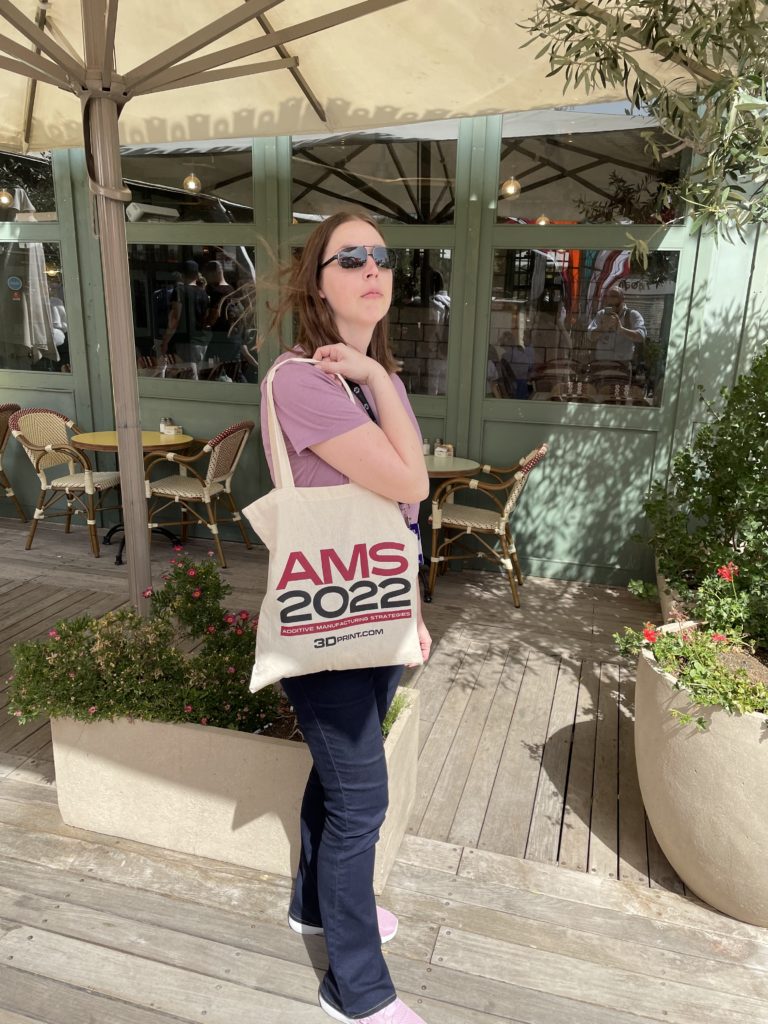 Repping 3DPrint.com in Jerusalem
Repping 3DPrint.com in Jerusalem
Subscribe to Our Email Newsletter
Stay up-to-date on all the latest news from the 3D printing industry and receive information and offers from third party vendors.
You May Also Like
Profiling a Construction 3D Printing Pioneer: US Army Corps of Engineers’ Megan Kreiger
The world of construction 3D printing is still so new that the true experts can probably be counted on two hands. Among them is Megan Kreiger, Portfolio Manager of Additive...
US Army Corps of Engineers Taps Lincoln Electric & Eaton for Largest 3D Printed US Civil Works Part
The Soo Locks sit on the US-Canadian border, enabling maritime travel between Lake Superior and Lake Huron, from which ships can reach the rest of the Great Lakes. Crafts carrying...
Construction 3D Printing CEO Reflects on Being Female in Construction
Natalie Wadley, CEO of ChangeMaker3D, could hear the words of her daughter sitting next to her resounding in her head. “Mum, MUM, you’ve won!” Wadley had just won the prestigious...
1Print to Commercialize 3D Printed Coastal Resilience Solutions
1Print, a company that specializes in deploying additive construction (AC) for infrastructure projects, has entered an agreement with the University of Miami (UM) to accelerate commercialization of the SEAHIVE shoreline...


